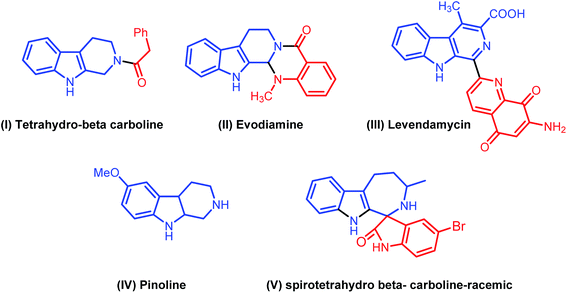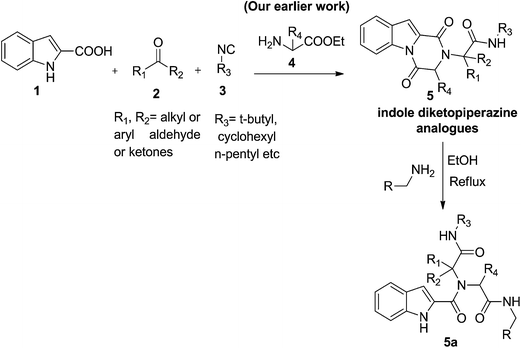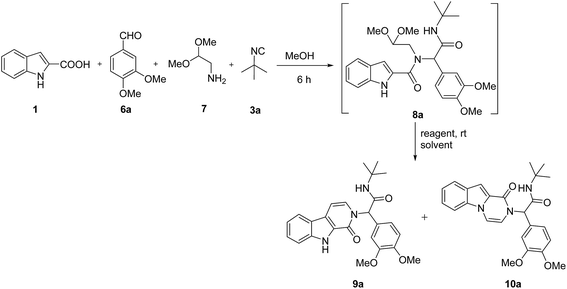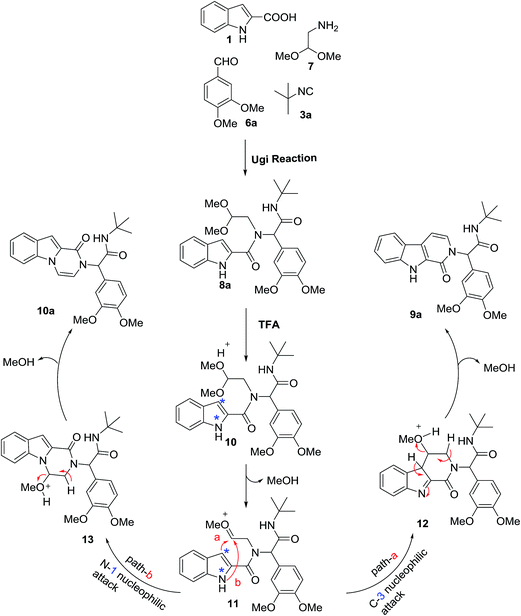Diversity oriented synthesis of β-carbolinone and indolo-pyrazinone analogues based on an Ugi four component reaction and subsequent cyclisation of the resulting indole intermediate†
Pooja Purohita,
Anand Kumar Pandeya,
Brijesh Kumarb and
Prem M. S. Chauhan*a
aMedicinal and Process Chemistry Division, CSIR-Central Drug Research Institute, Lucknow-226031, India. E-mail: Premsc58@hotmail.com; prem_chauhan_2000@yahoo.com; Fax: +91-522-2771941; Tel: +91-522-2771940 ext. 4659, 4660
bSophisticated Analytical Instrument Facility, CSIR-Central Drug Research Institute, Lucknow-226031, India
First published on 3rd February 2016
Abstract
A one-pot domino multicomponent reaction for the rapid, integrated and versatile synthesis of highly functionalized β-carbolinones (9a–9ab) and indolo-pyrazinones (10a–10ab) has been established. The reaction involves an Ugi-four component reaction of indole 2-carboxylic acid (1 or 16a–c), aryl or alkyl aldehyde (6a–p), isocyanide (3a–e), and aminoacetaldehyde dimethyl acetal (7) followed by in situ acid-mediated deprotection/activation/electrophilic cyclisation/and aromatisation. The products were obtained from Ugi adducts in good to excellent yield within short periods of 20–30 min at room temperature (35 °C). The potential of the methodology is proved by development of a diverse library of heterocyclic compounds with point and skeletal diversity. Moreover, the synthesis has also been accomplished using N-substituted derivatives of indole 2-carboxylic acid that delivers highly diverse N-substituted β-carbolinone (18a–l) heterocycles of medicinal importance.
Introduction
Much attention has been directed in the recent years towards isocyanide-based multi component reactions (IMCRs), especially the Ugi-four component reaction (Ugi-4CR),1 the Ugi-three component reaction (Ugi-3CR),2 and the Passerini reaction3 due to their ability to generate diverse heterocycles for medicinal chemistry. Aside from the vast array of more traditional methods, the Ugi-4CR offers a powerful and atom-economical way to construct functionalized molecular architectures from readily available starting materials such as aldehydes, amines, isocyanides, and carboxylic acids.4 These MCRs are of particular interest due to their mild reaction conditions, operational simplicity, atom economy, wide functional group tolerance, and are ideal for achieving environmentally friendly reactions.5 The combination of multicomponent reactions (MCRs) with post-condensation modifications via various ring-forming reactions has proven to be a powerful tool for accessing novel heterocyclic scaffolds. However the post modifications of Ugi products are generally restricted to a single chemical reaction which limits its scope in diversity oriented synthesis of complex molecules.6 Thus, the new domino Ugi/cyclisation reactions, which allowed the rapid construction of elaborate or highly functionalized heterocyclics in one single operation, has always been welcomed by the scientific community.7,8In recent decades, indole precursors have found extensive applications as a key component in multi component processes as they provide additional diversity and functionalization to product library.9 Indole nucleus containing natural product such as β-carboline, β-carbolinone, spirooxindoles etc., are not limited to privileged structures that have the ability to bind with several receptors else the attractive scaffolds for drug discovery.10 Indole heterocyclic, β-carboline core containing natural products and related synthetic derivatives have found extensive application in medicinal chemistry as antitumour, antimalarial, antileishmanial, anticancer, and other life style related diseases.11 It occurs in numerous natural products from fungi, bacteria, and plant isolates. Some of the examples have been shown (Fig. 1) like tetrahydro-β-carboline derivatives (I) having antitumour activity through inhibition of transforming growth factor beta (TGF-β).12 Likewise, evodiamine (II), a quinazolinocarboline alkaloid from chinese herb12 and lavendamycin (III), isolated from the fermentation broths of Streptomyces lavendulae, shows excellent antitumour activity.12 6-Methoxy-1,2,3,4-tetrahydro-β-carboline (pinoline) (IV) is believed to have a major role as an europrotective and in the regulation of adrenal gland.12 Racemic spirotetrahydro β-carboline-based spiroazepine indole (V) has also been recently shown to exhibit antiplasmodial activity.12
A pyrido-1-one annulated indole derivative, the β-carbolinone ring systems is a common motif plays a prominent role in organic and medicinal chemistry, such as affinity for the benzodiazepine receptor, antileukemic, and central nervous system depressing properties.13 Further, the β-carbolinone ring containing natural product strychnocarpine is a well-known muscle relaxant and a 5-hydroxytryptamine receptor stimulant.14 Beside having significant medicinal values, β-carbolinone heterocyclics have been less explored and, only a few methods for their syntheses have been reported in the literature. Among these are the first solid phase and liquid phase syntheses of β-carbolinones with the generation of four points diversity for various hydrophobic and hydrophilic groups by Wen-Ren Li et al.15 Later in 2008, Padwa et al., reported the preparation of a series of β-carbolinones in single step starting from N-propargyl indole-2-carboxamides.12c
Moreover, pyrazinones derivatives are found alone and/or embedded with several privilege heterocyclics which displays prominent biological activity and are featured in several naturally occurring molecules and synthetic derivatives.16 We have also been interested in the synthesis of indole fused pyrazinone heterocycles due to their significance in chemical biology.16 In pursuit of a protocol for preparing functionalized β-carbolinones (9) and indolo-pyrazinones (10) with diverse pharmacological properties, we envisioned the four component Ugi-MCR/post cyclisation approach using preorganised substrates. The scaffolds 9 and 10 illustrate the flexibility and complexity which is achieved in single operation and at the same time results in the combination of two the most bioactive rings indole and pyrido-2-one.
Indeed, our group has long had an interest in discovering new synthetic strategies utilising the Ugi MCR/post modification approaches for accessing biologically important heterocycles.17 Very recently, we reported the synthesis of biologically important indole diketopiperazine (5) analogues via four component Ugi reaction and subsequent ring opening leading to a library of dipeptides (Scheme 1).18 In this continuation, we next directed our efforts towards the reaction of the Ugi precursors indole-2-carboxylic acid (1) or N-substituted indole-2-carboxylic acid (16a–c), aryl or alkyl aldehyde (6a–p), and isocyanide (3), aminoacetaldehyde dimethyl acetal (7), and their subsequent deprotection/activation/electrophilic cyclisation/aromatisation at room temperature (35 °C) to afford diverse set of β-carbolinones (9) in good to excellent yield along with small amount of indolo-pyrazinones (10) (Scheme 2). It is noteworthy that, the new protocol avoids the use of any transition metal catalyst, thereby excluding their contamination during synthesis, favourable for biological screening.19
To the best of our knowledge, this is first report for such Ugi-4CR of indole 2-carboxylic acid, aminoacetaldehyde dimethyl acetal, aryl aldehyde, and isocyanide and/or subsequent cyclisation under acidic medium.
Result and discussion
As part of our on-going research on Ugi MCRs, we studied the reaction of indole-2-carboxylic acid (1), 3,4-dimethoxy benzaldehyde (6a), aminoacetaldehyde dimethyl acetal (7), and tertiary butyl isocyanides (3a) in methanol for 6 h at rt (35 °C), that resulted in the formation of Ugi adduct 8a as the major product. The methanol was removed in vacuo and further reaction was performed directly by stirring of Ugi adduct 8a in CH3CN under BF3·OEt2 (1.0 equiv.) for 60 min at rt (35 °C), which furnished the cyclised product 9a and 10a, albeit in lower yields (entry 2, Table 1).| Entry | Reagents (equiv.) | Solvents | Time (min) | Yieldb | |
|---|---|---|---|---|---|
| 9a | 10a | ||||
| a Reaction conditions: step 1: indole 2-carboxylic acid (1) (1 mmol), 3,4-dimethoxy benzaldehyde (6a) (1 mmol), aminoacetaldehyde dimethyl acetal (7) (1.1 mmol), tertiary butyl isocyanide (3a) (1.1 mmol) in 3 mL solvent, reaction time 6 h, rt (35 °C). Step 2: substrate Ugi adducts 8a (1 mmol), TFA (1.0 equiv.), solvent (2 mL), rt (35 °C), reaction time (20 min).b Isolated yield.c Unidentified mixture.d Reaction temperature (rt (35 °C) and/or 90 °C).e No reaction.f Reaction temperature (0 °C).g Reaction temperature (75 °C). | |||||
| 1 | BF3·OEt2 (1.0) | MeOH | 60 | 22 | 10 |
| 2 | BF3·OEt2 (1.0) | CH3CN | 60 | 45 | 11 |
| 3 | AlCl3 (1.0) | Toluene | 60 | 24 | Traces |
| 4 | TFA (0.2) | Toluene | 120 | 52 | 8 |
| 5 | TFA (0.2) | CH3CN | 120 | 66 | 8 |
| 6 | TFA (0.5) | CH3CN | 45 | 72 | 8 |
| 7 | TFA (1.0) | CH3CN | 20 | 79 | 11 |
| 8 | TFA (1.0) | THF | 20 | 73 | 8 |
| 9 | TFA (1.0) | DCM | 45 | 47 | 7 |
| 10 | TFA (1.0) | Chloroform | 45 | 46 | 7 |
| 11 | TFA (2.0) | CH3CN | 20 | 78 | 10 |
| 12 | PTSA (0.2) | CH3CN | 120 | 52 | 8 |
| 13 | PTSA (1.0) | CH3CN | 20 | 72 | 9 |
| 14 | MSA (1.0) | CH3CN | 30 | 69 | 8 |
| 15 | TFMSA (1.0) | CH3CN | 30 | 57 | 7 |
| 16 | HClO4 (1.0) | CH3CN | 60 | UNc | — |
| 17 | Acetic acid | — | 60 | UNd | — |
| 18 | Acetic acid (5.0) | Toluene | 60 | UNd | — |
| 19 | — | CH3CN | >120 | NRe | — |
| 20 | TFA (1.0) | CH3CN | 60 | 65f | 7 |
| 21 | TFA (1.0) | CH3CN | 15 | 45g | 7 |
The products 9a and 10a were isolated from column chromatography and characterised by IR, HRMS, 1H NMR and 13C NMR spectra (see ESI†).20 To identify the optimal reaction conditions for the domino reaction, we checked different catalysts, solvents and temperatures and the results of this study are depicted in Table 1.
To obtain the desired product (9a and 10a), we tested the reaction using different Brønsted and Lewis acids which is depicted in Table 1. The one step one pot reaction of Ugi/cyclisation reaction using BF3·OEt2 under MeOH was unsuccessful since the reaction generates additional impurities in the reaction mixture, restricting the use of MeOH as solvent for promoting cyclisation (entry 1, Table 1). Performing the cyclisation with AlCl3 in toluene generates inseparable reaction mixture (entry 3, Table 1). Next, we examine a set of Brønsted acids in different solvents (entries 4–21, Table 1) where, trifluoro acetic acid (TFA) (entry 7, Table 1), p-toluene sulphonic acid (PTSA) (entry 13, Table 1), and/or methanesulphonic acid (MSA) (entry 14, Table 1) seemed promising for cyclisation of Ugi product. It may be due to the acidic strength of TFA (pKa ∼ −0.25), PTSA (pKa ∼ −2.58) and, MSA (pKa ∼ −2.60) are good enough to enhance the electrophilicity of the oxo-group for intramolecular cyclisation via C-3 or N-1 position of indole ring consequently good yield of cyclisation. However, in case of triflouromethanesulphonic acid (TFMSA, pKa ∼ −14.0) (entry 15, Table 1) and/or perchloric acid (HClO4, pKa ∼ −10.0) (entry 16, Table 1), being highly acidic in nature may protonate the N-1 of indole ring and thus reduce the nucleophilicity of C-3 carbon of indole ring thus leads the low yield of cyclized product. In other hand, the acid (like CH3COOH, pKa ∼ +4.76) having high pKa value i.e. weak acidic strength is not enough to enhance the electrophilicity of oxo-group therefore low feasibility of cyclisation (entry 17 and 18, Table 1).
Due to the volatile nature of TFA (72 °C) and easily removed by evaporation without neutralization or extraction in organic solvents, is the reagent of choice which prompted us to further optimize the reaction condition using TFA. Therefore, further refinement was limited to varying the solvent and temperature. We also investigated the amount of TFA required for this reaction and it was observed that with decreasing the amount of catalyst, the yields also decreased (entries 5–7, Table 1). It is observed that further increase of the catalyst loading to 2.0 equiv. has no obvious influence on the reaction (entry 11, Table 1). Subsequently, the effect of solvent was examined where DCM, and/or CHCl3 showed no superiority to toluene as solvents but in THF and/or CH3CN a good yield of product was observed with reduction in reaction time (compare entries 4, 7–10, Table 1). When the reaction was carried out using 1.0 equivalent of TFA in CH3CN, a complete disappearance of starting materials was observed while attaining the highest yield of 9a and 10a (79% and 11% yield respectively, entry 7, Table 1). As predicted, the reaction did not work at all without cyclizing reagent (entry 19, Table 1). We have also done the Ugi post cyclisation reaction at lower temperature (0 °C) which delivered the low yield of regioisomers in longer time (entry 20, Table 1). It is noteworthy that, at a reaction temperature of 75 °C, the yield of the desired product was decreased significantly (entry 21, Table 1).
The scope and limitations of this one pot domino Ugi/cyclisation process (entry 7, Table 1), were next examined by employing diverse aromatic/heteroaromatic (HetAr)/aliphatic aldehydes appended with various substituents (6a–i, Table 2). The complete list of the synthesized compounds (9a–9ab and 10a–10ab) with corresponding starting materials is given in the ESI (S-Table 1†). It is interesting to note that in all cases whether aromatic aldehydes with electron-withdrawing and/or electron-donating groups were used, products were obtained with minimal variation in isolated yields (Table 2; 58–79%). The presented protocol shows extensive evaluation of the transformation that not only reveals novel reactivity facets and expanded scope of the method but also provides β-carbolinone and indolo-pyrazinone chemotypes featuring unexplored functional, skeletal, and fusion patterns of indole heterocycles. We have synthesized several β-carbolinone and indolo-pyrazinone derivatives containing halogens such as fluoro, chloro, bromo based on their role in introducing lipophilicity in molecules in medicinal chemistry (entry 4, Table 2 and see ESI; Table 1†). The 4-nitro benzaldehyde (6c) with a strong electron withdrawing substituent also provides the cyclized product in good yield (entry 3, Table 2). Sterically hindered 1-naphthaldehyde (6f) with tertiary butyl isocyanide (3a) provides the cyclized products in 74% yield (entry 6, Table 2). Further, 4-hydroxy benzaldehyde (6e) and n-pentanal (6g) were also used as aldehyde sources for extensively evaluating the chemoselectivity profile of the transformation. The 1,4-terephthalaldehyde has also demonstrated usefulness for domino Ugi/cyclisation reactions, leading to the bis analogue of β-carbolinone as the major product in good yield (entries 12, Table 2).21 Inspired by the biological activity of marinocarboline A–D22 containing the β-carboline nucleus, we have utilised a indole 3-carboxaldehyde precursor, which delivered β-carboline (inseparable from reaction mixture) and indolo-pyrazinone polyheterocycles in relatively lower yield (entry 13, Table 2). However, we were unable to obtain any product from ketones under the optimized conditions which limits this methodology for such substrates. Cyclohexyl isocyanide (3b), 1,1,3,3-tetramethyl butyl isocyanide (3c), 4-methoxyphenyl isocyanide (3d), and n-pentyl isocyanide (3e) were also used as isocyanides for diversification in the products library.
| Entry | Starting material | Cyclised product yield%b | |
|---|---|---|---|
| 9 | 10 | ||
| a Reaction conditions: step 1: indole 2-carboxylic acid (1) (1 mmol), aryl or alkyl aldehyde (6a–i) (1 mmol), aminoacetaldehyde dimethyl acetal (7) (1.1 mmol), alkyl or aryl isocyanide (3a–e) (1.1 mmol) in 3 mL solvent at rt (35 °C). Step 2: substrate Ugi adducts 8a–m (1 mmol), TFA (1.0 equiv.), CH3CN (2 mL), reaction time (20–30 min), rt (35 °C).b Isolated yield.c Inseparable from reaction mixture. | |||
| 1 | 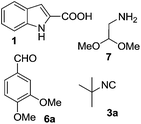 |
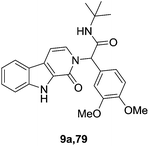 |
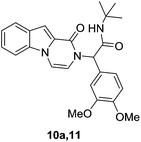 |
| 2 | 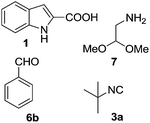 |
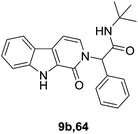 |
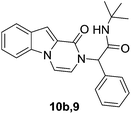 |
| 3 | 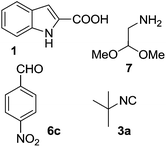 |
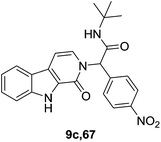 |
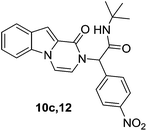 |
| 4 | 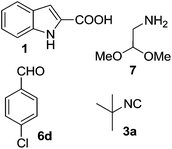 |
 |
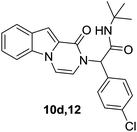 |
| 5 | 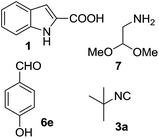 |
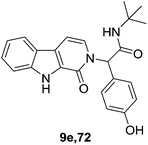 |
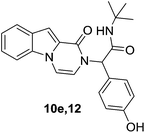 |
| 6 | 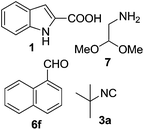 |
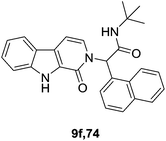 |
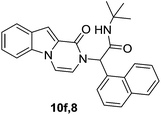 |
| 7 | 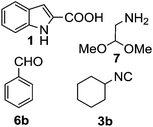 |
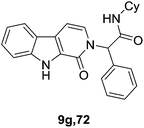 |
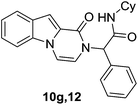 |
| 8 |  |
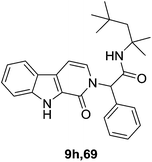 |
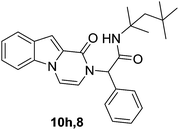 |
| 9 | 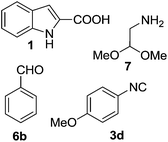 |
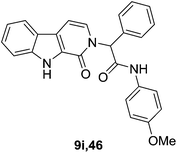 |
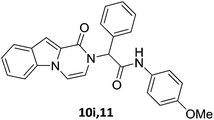 |
| 10 | 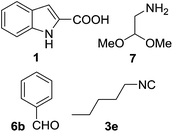 |
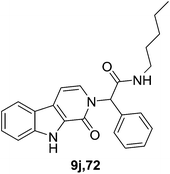 |
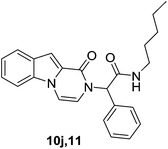 |
| 11 | 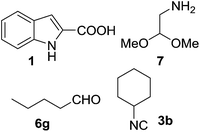 |
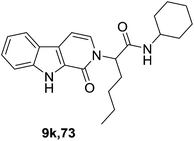 |
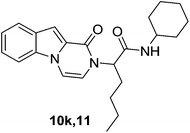 |
| 12 |  |
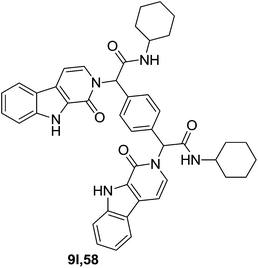 |
|
| 13 | 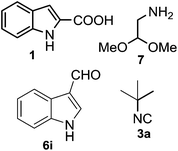 |
9mc | 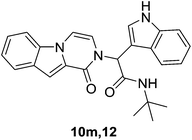 |
A proposed mechanism of the TFA-mediated domino reaction for both of the cyclised product 9a and 10a is depicted in Fig. 2. The first step is the general Ugi reaction which includes continuous stirring of Ugi precursors for 4–6 h at rt (35 °C). The second step includes a domino deprotection, activation, and electrophilic cyclisation followed by aromatisation for product formation. Based on a literature survey, we envisaged that such a transformation can only occur under acid medium.23 The Ugi precursor, subjected to TFA for protonation involves the conversion of acetal to aldehyde first, which then forms an oxonium ion 11. This oxonium ion 11 has two nucleophilic centres indole N-1 and indole C-3 which can attack to the positive carbon. Out of the two possibilities, the most nucleophilic site is indole C-3, which attacks first and provides the cyclised intermediate 12. This intermediate 12 afforded the desired product 9a in good yield with removal of methanol, presumably because of the acidic conditions employed. The product 10a is found as a minor side product via intermediate 13, and results from the involvement of indole N-1 site in cyclisation.
Further, we have extended the substrate scope of this domino reaction by introducing N-substituted indole-3-carboxylic acids as a carboxylic acid component. The desired N-substituted indole-2-carboxylic acids (16a–c) were achieved in good yield only in three steps starting from indole-2-carboxylic acid. Prior to N-functionalization, the substrate 1 was protected through ester formation with thionyl chloride/ethanol leading to indole-2-carboxylic ethyl ester 14. This intermediate 14 is reacted with corresponding alkyl or benzyl or propargyl halide in presence of NaH in DMF providing N-substituted indole-2-carboxylic ethyl ester 15a–c. This is followed by hydrolysis with KOH in equimolar ratios of THF![[thin space (1/6-em)]](https://www.rsc.org/images/entities/char_2009.gif) :
:![[thin space (1/6-em)]](https://www.rsc.org/images/entities/char_2009.gif) MeOH
MeOH![[thin space (1/6-em)]](https://www.rsc.org/images/entities/char_2009.gif) :
:![[thin space (1/6-em)]](https://www.rsc.org/images/entities/char_2009.gif) H2O solvent providing the salt of the carboxylic acid which upon neutralisation with dilute hydrochloric acid (pH = 2) provided the desired Ugi precursor N-substituted indole-2-carboxylic acid (16a–c) in moderate to good yield (see ESI, Scheme 1†).
H2O solvent providing the salt of the carboxylic acid which upon neutralisation with dilute hydrochloric acid (pH = 2) provided the desired Ugi precursor N-substituted indole-2-carboxylic acid (16a–c) in moderate to good yield (see ESI, Scheme 1†).
Once these N-substituted indole-2-carboxylic acids (16a–c) were in hand, they were subjected to domino Ugi 4CR/cyclisation reaction together with an aryl aldehyde (6a or 6b or 6d or 6e or 6h or 6j), aminoacetaldehyde dimethyl acetal (7), and isocyanides (3a–c) under our optimised reaction conditions. Interestingly, all the N-substituted indole-2-carboxylic acids were successfully transformed into the desired N-substituted β-carbolinone analogues (18a–l) in excellent yield. Moreover, we found that in all cases products were obtained with minimal variation in isolated yield. We have also notice that cyclisation reaction of Ugi adduct of N-substituted precursors were achieved in lesser time (15–20 min) compared to that of the Ugi product derived from 1H-indole-2-carboxylic acid (20–30 min), which may be due to indole ring activation from the substituents (alkyl, benzyl and propargyl groups). The input of propargyl group over the N-1 position of indole allows a further diversification point on carbolinone heterocycle (entry 9–12, Table 3), which could be highly desirable for structural and biological activity assessments. These propargyl linked carbolinones can be further elaborated using various reactions for e.g. [3 + 2]-click reactions,24 aldehyde/alkyne/secondary amine coupling reactions,25 Sonogashira reactions26 and many other cyclisation reactions.27
| Entry | Starting material | Cyclised product (18a–l) | Yield%b |
|---|---|---|---|
| a Reaction conditions: step 1: N-substituted indole 2-carboxylic acid (16a–c) (1 mmol), aryl aldehyde (6a, 6b, 6d, 6e, 6h, 6j) (1 mmol), aminoacetaldehyde dimethyl acetal (7) (1.1 mmol), alkyl isocyanide (3a–c) (1.1 mmol) in 3 mL solvent, 4–6 h, rt (35 °C). Step 2: substrate Ugi adducts 17a–l (1 mmol), TFA (1.0 equiv.), CH3CN (2 mL), reaction time (15–20 min), rt (35 °C).b Isolated yield. | |||
| 1 | 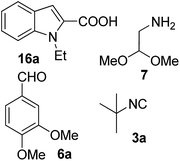 |
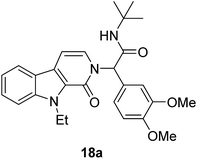 |
79 |
| 2 | 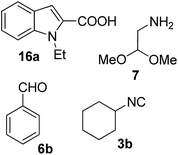 |
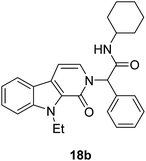 |
81 |
| 3 | 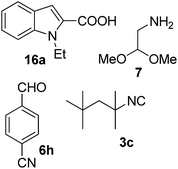 |
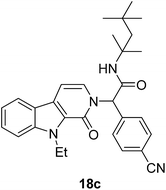 |
77 |
| 4 | 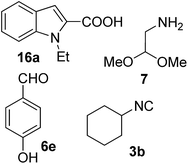 |
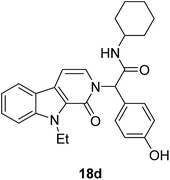 |
68 |
| 5 | 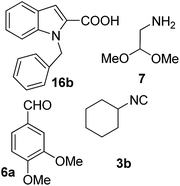 |
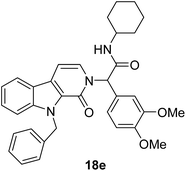 |
72 |
| 6 | 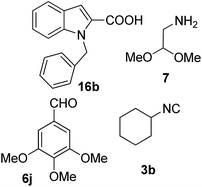 |
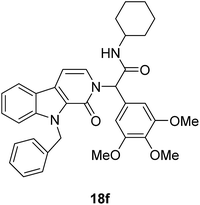 |
77 |
| 7 | 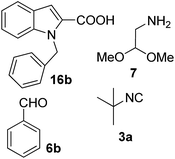 |
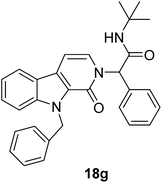 |
69 |
| 8 | 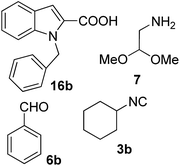 |
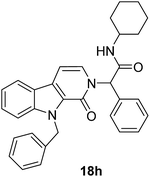 |
68 |
| 9 | 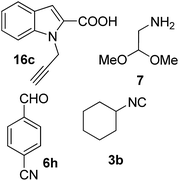 |
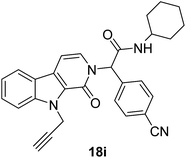 |
71 |
| 10 | 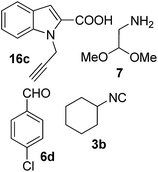 |
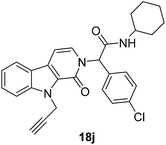 |
74 |
| 11 | 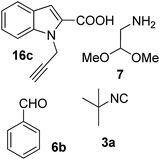 |
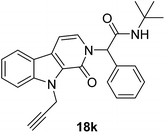 |
69 |
| 12 | 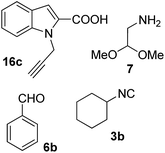 |
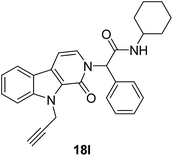 |
64 |
Conclusion
In Summary, we have constructed a library of biologically valuable heterocyclic compounds using domino Ugi/post cyclisation approach in a one pot procedure. Our methodology is straightforward to execute and useful in the preparation of wide variety of β-carbolinones and indolo-pyrazinones analogues. In addition, we also applied our protocol to N-substituted indole 2-carboxylic acid precursors which delivered indole C-3 cyclised β-carbolinones in excellent yield. The salient feature of our protocol is atom economy, operational simplicity, high yield and easily available precursors in a very short period of time. By further elaboration and diversification of the various functionally substituted scaffolds, a wide range of structurally and spatially diverse compounds can be produced. We anticipated that this protocol will open the door for the medicinal chemist to synthesise such frameworks and test for biological activity.Experimental section
General
Melting points are uncorrected and were determined in capillary tubes on a precision melting point apparatus containing silicon oil. IR spectra were recorded on an FTIR spectrophotometer and are reported in terms of frequency of absorption (cm−1). 1H NMR spectra were recorded on a 400 MHz and 500 MHz spectrometer in CDCl3 or DMSO-d6 (all signals are reported in ppm with the internal chloroform signal at 7.26–7.28 ppm, or the internal DMSO signal at 2.50 ppm as standard). 13C NMR spectra were recorded on 100 MHz and 125 MHz spectrometers in CDCl3 or DMSO-d6 (all signals are reported in ppm with the internal chloroform signal at 77.21 ppm, or the internal DMSO signal at 39.51 ppm as standard). Chemical shifts δ are given in ppm relative to the residual signals of tetramethylsilane in CDCl3 or deuterated solvent CDCl3/DMSO-d6 for 1H and 13C NMR spectrometers. Coupling constants J are reported in hertz (Hz). Multiplicities are reported as follows: singlet (s), broad (br), doublet (d), triplet (t), quartet (q), and multiplet (m). The HRMS spectra were recorded as ESI-HRMS on Q-TOF, LC-MS/MS mass spectrometer. Reaction progress was routinely monitored by thin-layer chromatography (TLC) on precoated silica gel plates. Column chromatography was performed over silica gel. All the solvents and chemicals were used as procured from the suppliers.Experimental procedure
General procedure 1
N-(tert-Butyl)-2-(3,4-dimethoxyphenyl)-2-(1-oxo-1H-pyrido[3,4-b]indol-2(9H)-yl)acetamide (9a). Isolated as a green solid; 79% yield (342 mg); mp 150–153 °C; IR (KBr) νmax: 3398, 3019, 1647, 1215, 757 cm−1; 1H NMR (400 MHz, CDCl3) δ: 11.00 (s, 1H), 7.93 (d, J = 8 Hz, 1H), 7.63 (d, J = 8.2 Hz, 1H), 7.45 (t, J = 7.8 Hz, 1H), 7.23 (t, J = 7.6 Hz, 1H), 7.18 (d, J = 7.3 Hz, 1H), 7.06 (d, J = 8 Hz, 1H), 6.98 (s, 1H), 6.96 (d, J = 4.9 Hz, 1H), 6.94 (s, 1H), 6.90 (d, J = 8.1 Hz, 1H), 6.27 (s, 1H), 3.90 (s, 3H), 3.80 (s, 3H), 1.40 (s, 9H) ppm; 13C NMR (100 MHz, CDCl3) δ: 167.6, 156.0, 149.4, 140.1, 128.0, 127.1, 127.0, 126.6, 125.3, 122.2, 121.7, 121.3, 120.0, 112.6, 112.0, 111.3, 101.4, 61.1, 55.8, 52.0, 28.6 ppm; HRMS (ESI) calcd for [C25H28N3O4]+ 434.2080; found 434.2065.
N-(tert-Butyl)-2-(3,4-dimethoxyphenyl)-2-(1-oxopyrazino[1,2-a]indol-2(1H)-yl)acetamide (10a). Isolated as a yellow solid; 11% yield (47 mg); mp 90–93 °C; IR (KBr) νmax: 3393, 2926, 1627, 1068, 762 cm−1; 1H NMR (400 MHz, CDCl3) δ: 7.84 (d, J = 8 Hz, 1H), 7.63 (d, J = 8.6 Hz, 1H), 7.44 (s, 1H), 7.41 (t, J = 7.5 Hz, 1H), 7.33 (t, J = 7.5 Hz, 1H), 7.24 (d, J = 6.2 Hz, 1H), 7.06 (d, J = 8.3 Hz, 1H), 6.94 (d, J = 1.9 Hz, 1H), 6.92 (d, J = 8.4 Hz, 1H), 6.63 (s, 1H), 6.55 (d, J = 6.2 Hz, 1H), 5.98 (s, 1H), 3.91 (s, 3H), 3.86 (s, 3H), 1.41 (s, 9H) ppm; 13C NMR (100 MHz, CDCl3) δ: 167.6, 157.4, 149.4, 132.1, 127.7, 127.4, 127.2, 124.1, 122.6, 122.4, 121.6, 113.3, 111.9, 111.3, 110.5, 105.7, 103.3, 59.2, 55.9, 52.1, 28.6 ppm; HRMS (ESI) calcd for [C25H28N3O4]+ 434.2080; found 434.2065.
N-(tert-Butyl)-2-(1-oxo-1H-pyrido[3,4-b]indol-2(9H)-yl)-2-phenylacetamide (9b). Isolated as a white solid; 64% yield (238 mg); mp 123–126 °C; IR (KBr) νmax: 3310, 3019, 1648, 1216, 759 cm−1; 1H NMR (400 MHz, CDCl3) δ: 10.58 (s, 1H), 7.95 (d, J = 7.9 Hz, 1H), 7.61 (d, J = 8.4 Hz, 1H), 7.51 (d, J = 7.3 Hz, 1H), 7.47–7.43 (m, 5H), 7.27 (t, J = 7.5 Hz, 1H), 7.20 (d, J = 7.4 Hz, 1H), 7.03 (d, J = 7 Hz, 1H), 6.96 (s, 1H), 6.07 (bs, 1H), 1.41 (s, 9H) ppm; 13C NMR (100 MHz, CDCl3) δ: 167.4, 155.6, 140.3, 135.6, 129.2, 129.1, 129.0, 127.5, 126.8, 126.7, 126.1, 121.9, 121.3, 120.3, 112.7, 102.3, 61.9, 52.2, 28.5 ppm; HRMS (ESI) calcd for [C23H24N3O2]+ 374.1869; found 374.1859.
N-(tert-Butyl)-2-(1-oxopyrazino[1,2-a]indol-2(1H)-yl)-2-phenylacetamide (10b). Isolated as an orange solid; 9% yield (33 mg); mp 151–155 °C; IR (KBr) νmax: 3422, 3019, 1630, 1215, 758 cm−1; 1H NMR (400 MHz, CDCl3) δ: 7.84 (d, J = 7.9 Hz, 1H), 7.62 (d, J = 8.6 Hz, 1H), 7.47–7.41 (m, 4H), 7.39 (d, J = 6.7 Hz, 2H), 7.33 (s, 1H), 7.31 (t, J = 7.6 Hz, 1H), 7.24 (d, J = 6 Hz, 1H), 6.74 (s, 1H), 6.56 (d, J = 6.1 Hz, 1H), 6.03 (s, 1H), 1.42 (s, 9H) ppm; 13C NMR (100 MHz, CDCl3) δ: 167.4, 157.4, 135.5, 132.1, 129.1, 128.9, 128.8, 127.7, 127.2, 124.1, 122.6, 122.4, 113.4, 110.4, 105.7, 103.4, 59.2, 52.1, 28.6 ppm; HRMS (ESI) calcd for [C23H24N3O2]+ 374.1869; found 374.1865.
N-(tert-Butyl)-2-(4-nitrophenyl)-2-(1-oxo-1H-pyrido[3,4-b]indol-2(9H)-yl)acetamide (9c). Isolated as a yellow solid; 67% yield (280 mg); mp 120–123 °C; IR (KBr) νmax: 3398, 3019, 1648, 1215, 769 cm−1; 1H NMR (400 MHz, CDCl3) δ: 10.11 (s, 1H), 8.29 (d, J = 8.6 Hz, 1H), 8.24 (s, 1H), 8.22 (s, 1H), 7.96 (d, J = 7.9 Hz, 1H), 7.57 (s, 2H), 7.55 (s, 1H), 7.22 (d, J = 7.2 Hz, 1H), 7.05 (s, 1H), 7.03 (d, J = 7.1 Hz, 1H), 6.99 (s, 1H), 6.41 (s, 1H), 1.41 (s, 9H) ppm; 13C NMR (100 MHz, CDCl3) δ: 168.8, 166.4, 155.7, 143.2, 141.4, 139.8, 129.8, 129.4, 127.5, 126.1, 125.6, 124.2, 124.0, 121.4, 120.6, 112.4, 102.2, 60.3, 52.4, 28.5 ppm. HRMS (ESI) calcd for [C23H23N4O4]+ 419.1719; found 419.1701.
N-(tert-Butyl)-2-(4-nitrophenyl)-2-(1-oxopyrazino[1,2-a]indol-2(1H)-yl)acetamide (10c). Isolated as a pale yellow solid; 12% yield (50 mg); mp 130–133 °C; IR (KBr) νmax: 3399, 3019, 1648, 1215, 770 cm−1; 1H NMR (400 MHz, CDCl3) δ: 8.26 (d, J = 8.9 Hz, 2H), 7.83 (d, J = 8 Hz, 1H), 7.62 (d, J = 8.5 Hz, 3H), 7.43 (t, J = 6.8 Hz, 2H), 7.34 (d, J = 7.8 Hz, 1H), 7.31 (s, 1H), 6.88 (s, 1H), 6.64 (d, J = 6.2 Hz, 1H), 6.60 (s, 1H), 1.43 (s, 9H) ppm; 13C NMR (100 MHz, CDCl3) δ: 166.3, 157.3, 147.9, 142.6, 132.3, 129.5, 127.6, 126.5, 124.7, 124.1, 122.8, 122.7, 112.5, 110.5, 106.7, 104.3, 58.3, 52.5, 28.6 ppm; HRMS (ESI) calcd for [C23H23N4O4]+ 419.1719; found 419.1713.
N-(tert-Butyl)-2-(4-chlorophenyl)-2-(1-oxo-1H-pyrido[3,4-b]indol-2(9H)-yl)acetamide (9d). Isolated as a white solid; 62% yield (252 mg); mp 113–116 °C; IR (KBr) νmax: 3400, 3019, 1622, 1215, 757 cm−1; 1H NMR (400 MHz, CDCl3) δ: 11.16 (s, 1H), 7.92 (d, J = 7.8 Hz, 1H), 7.59 (d, J = 8.5 Hz, 1H), 7.43 (t, J = 7.4 Hz, 2H), 7.23 (t, J = 7.5 Hz, 2H), 7.17 (d, J = 7.4 Hz, 2H), 7.13 (s, 2H), 6.97 (d, J = 7.4 Hz, 1H), 6.49 (s, 1H), 1.40 (s, 9H) ppm; 13C NMR (100 MHz, CDCl3) δ: 167.2, 156.0, 140.1, 134.7, 130.2, 129.2, 127.0, 126.4, 125.3, 122.1, 121.3, 120.2, 112.6, 101.8, 60.4, 52.1, 28.6 ppm; HRMS (ESI) calcd for [C23H23ClN3O2]+ 408.1479; found 408.1465.
N-(tert-Butyl)-2-(4-chlorophenyl)-2-(1-oxopyrazino[1,2-a]indol-2(1H)-yl)acetamide (10d). Isolated as a white solid; 11% yield (44 mg); mp 135–137 °C; IR (KBr) νmax: 3400, 3019, 1628, 1215, 757 cm−1; 1H NMR (400 MHz, CDCl3) δ: 7.85 (d, J = 8 Hz, 1H), 7.64 (d, J = 8.2 Hz, 1H), 7.45 (s, 1H), 7.43 (t, J = 8 Hz, 1H), 7.39 (t, J = 1.1 Hz, 1H), 7.30 (s, 1H), 7.28 (s, 1H), 7.26 (d, J = 6.1 Hz, 1H), 6.68 (s, 1H), 6.55 (d, J = 6.1 Hz, 1H), 6.01 (s, 1H), 1.41 (s, 9H) ppm; 13C NMR (100 MHz, CDCl3) δ: 167.1, 157.3, 134.8, 134.0, 132.2, 130.2, 129.3, 127.6, 126.9, 124.3, 122.6, 113.1, 110.5, 106.0, 103.6, 58.4, 52.2, 28.6 ppm; HRMS (ESI) calcd for [C23H23ClN3O2]+ 408.1479; found 408.1473.
N-(tert-Butyl)-2-(4-hydroxyphenyl)-2-(1-oxo-1H-pyrido[3,4-b]indol-2(9H)-yl)acetamide (9e). Isolated as a white solid; 72% yield (280 mg); mp 160–163 °C; IR (KBr) νmax: 3400, 3019, 1647, 1215, 758 cm−1; 1H NMR (400 MHz, DMSO-d6) δ: 9.63 (s, 1H), 8.20 (s, 1H), 7.98 (d, J = 8 Hz, 1H), 7.54 (d, J = 8.1 Hz, 1H), 7.45–7.39 (m, 2H), 7.27 (d, J = 8.6 Hz, 1H), 7.19 (d, J = 7.3 Hz, 1H), 7.14 (d, J = 8.5 Hz, 1H), 6.96 (d, J = 7 Hz, 1H), 6.90 (s, 1H), 6.82 (s, 1H), 6.80 (s, 1H), 6.78 (s, 1H), 1.29 (s, 9H) ppm; 13C NMR (100 MHz, CDCl3 + DMSO-d6) δ: 168.0, 157.3, 155.8, 139.7, 130.4, 127.1, 126.6, 126.2, 125.4, 122.0, 121.2, 120.0, 115.9, 112.2, 101.1, 61.0, 51.6, 28.2 ppm; HRMS (ESI) calcd for [C23H24N3O3]+ 390.1818; found 390.1804.
N-(tert-Butyl)-2-(4-hydroxyphenyl)-2-(1-oxopyrazino[1,2-a]indol-2(1H)-yl)acetamide (10e). Isolated as a white solid; 12% yield (47 mg); mp 150–153 °C; IR (KBr) νmax: 3400, 3019, 1625, 1216, 769 cm−1; 1H NMR (400 MHz, CDCl3) δ: 7.82 (d, J = 8.1 Hz, 1H), 7.61 (d, J = 8.3 Hz, 1H), 7.43 (s, 1H), 7.40 (t, J = 7.6 Hz, 1H), 7.32 (d, J = 7.8 Hz, 1H), 7.27 (d, J = 8.3 Hz, 2H), 7.23 (d, J = 6 Hz, 1H), 6.87 (d, J = 8.5 Hz, 2H), 6.56 (s, 1H), 6.51 (d, J = 6.1 Hz, 1H), 6.00 (s, 1H), 1.39 (s, 9H) ppm; 13C NMR (100 MHz, DMSO-d6) δ: 168.0, 157.9, 156.5, 132.1, 130.6, 127.6, 127.4, 126.7, 124.2, 122.8, 122.5, 116.1, 114.6, 112.0, 105.7, 102.3, 58.8, 51.1, 28.8 ppm; HRMS (ESI) calcd for [C23H24N3O3]+ 390.1818; found 390.1822.
N-(tert-Butyl)-2-(naphthalen-1-yl)-2-(1-oxo-1H-pyrido[3,4-b]indol-2(9H)-yl)acetamide (9f). Isolated as a white solid; 74% yield (313 mg); mp 220–223 °C; IR (KBr) νmax: 3399, 3019, 1647, 1215, 758 cm−1; 1H NMR (400 MHz, CDCl3) δ: 10.43 (s, 1H), 8.01–7.96 (m, 2H), 7.91–7.86 (m, 3H), 7.66 (d, J = 2.8 Hz, 1H), 7.63 (d, J = 5.4 Hz, 1H), 7.60 (d, J = 7.7 Hz, 1H), 7.50–7.45 (m, 1H), 7.44–7.41 (m, 2H), 7.23 (t, J = 7.6 Hz, 1H), 7.04 (d, J = 7.2 Hz, 1H), 6.83 (d, J = 7.3 Hz, 1H), 5.96 (s, 1H), 1.44 (s, 9H) ppm; 13C NMR (100 MHz, CDCl3) δ: 167.9, 155.7, 139.9, 134.1, 131.7, 130.2, 128.9, 127.7, 127.6, 127.2, 126.9, 126.4, 126.3, 125.2, 123.1, 122.3, 121.3, 120.0, 112.6, 101.0, 58.4, 52.2, 28.6 s ppm; HRMS (ESI) calcd for [C27H26N3O2]+ 424.2025; found 424.2023.
N-(tert-Butyl)-2-(naphthalen-1-yl)-2-(1-oxopyrazino[1,2-a]indol-2(1H)-yl)acetamide (10f). Isolated as a white solid; 8% yield (34 mg); mp 140–143 °C; IR (KBr) νmax: 3419, 3019, 1618, 1215, 756 cm−1; 1H NMR (400 MHz, CDCl3) δ: 8.00–7.95 (m, 2H), 7.92–7.89 (m, 1H), 7.84 (d, J = 7.8 Hz, 2H), 7.60 (d, J = 7.7 Hz, 1H), 7.56 (s, 1H), 7.54 (d, J = 2.4 Hz, 1H), 7.53 (t, J = 4 Hz, 2H), 7.38 (t, J = 7 Hz, 1H), 7.32 (d, J = 5.9 Hz, 2H), 7.12 (d, J = 6.2 Hz, 1H), 6.41 (d, J = 6 Hz, 1H), 5.81 (s, 1H), 1.44 (s, 9H) ppm; 13C NMR (100 MHz, CDCl3) δ: 167.9, 157.0, 134.0, 132.0, 131.6, 131.0, 130.2, 128.9, 127.7, 127.1, 126.5, 125.1, 124.1, 123.0, 122.5, 122.4, 113.0, 110.4, 105.6, 103.4, 56.7, 52.2, 28.6 ppm; HRMS (ESI) calcd for [C27H26N3O2]+ 424.2025, found 424.2022.
N-Cyclohexyl-2-(1-oxo-1H-pyrido[3,4-b]indol-2(9H)-yl)-2-phenylacetamide (9g). Isolated as a white solid; 72% yield (287 mg); mp 171–174 °C; IR (KBr) νmax: 3400, 3019, 2933 1650, 1215, 759 cm−1; 1H NMR (400 MHz, CDCl3) δ: 10.80 (s, 1H), 7.93 (d, J = 7.9 Hz, 1H), 7.58 (d, J = 8.4 Hz, 1H), 7.46 (d, J = 2.5 Hz, 1H), 7.44 (m, 2H), 7.42 (t, J = 1.4 Hz, 2H), 7.406–7.400 (t, J = 1.6 Hz, 1H), 7.21 (d, J = 7.3 Hz, 2H), 7.10 (s, 1H), 6.96 (d, J = 7 Hz, 1H), 6.31 (d, J = 8 Hz, 1H), 3.94–3.86 (m, 1H), 2.01 (d, J = 12.5 Hz, 1H), 1.93 (d, J = 9.6 Hz, 2H), 1.71–1.65 (m, 2H), 1.62–1.57 (m, 1H), 1.39–1.32 (m, 2H), 1.19–1.13 (m, 2H) ppm; 13C NMR (100 MHz, DMSO-d6) δ: 167.3, 155.5, 139.9, 137.6, 129.3, 128.9, 128.6, 127.7, 127.3, 126.8, 123.6, 122.2, 121.6, 120.0, 113.0, 99.7, 59.6, 48.5, 32.6, 32.6, 25.6, 24.9 ppm; HRMS (ESI) calcd for [C25H26N3O2]+ 400.2025; found 400.2021.
N-Cyclohexyl-2-(1-oxopyrazino[1,2-a]indol-2(1H)-yl)-2-phenylacetamide (10g). Isolated as a white solid; 12% yield (48 mg); mp 170–173 °C; IR (KBr) νmax: 3400, 3019, 2929, 1629, 1215, 757 cm−1; 1H NMR (400 MHz, CDCl3) δ: 7.83 (d, J = 8.1 Hz, 1H), 7.63 (d, J = 8.3 Hz, 1H), 7.46–7.38 (m, 7H), 7.33 (d, J = 7.6 Hz, 1H), 7.25 (d, J = 6 Hz, 1H), 6.80 (s, 1H), 6.62 (d, J = 5.8 Hz, 1H), 6.26 (d, J = 8 Hz, 1H), 3.90–3.87 (m, 1H), 2.03 (d, J = 12.5 Hz, 1H), 1.96 (d, J = 12.4 Hz, 1H), 1.75–1.68 (m, 2H), 1.64–1.59 (m, 1H), 1.44–1.34 (m, 2H), 1.25–1.14 (m, 3H) ppm; 13C NMR (100 MHz, CDCl3) δ: 167.2, 157.4, 135.3, 132.1, 129.1, 128.8, 127.7, 127.1, 124.1, 122.6, 122.4, 113.4, 110.5, 105.8, 103.5, 59.0, 48.9, 32.8, 32.7, 25.4, 24.7 ppm; HRMS (ESI) calcd for [C25H26N3O2]+ 400.2025; found 400.2022.
2-(1-Oxo-1H-pyrido[3,4-b]indol-2(9H)-yl)-2-phenyl-N-(2,4,4-trimethylpentan-2-yl)acetamide (9h). Isolated as a green solid; 69% yield (296 mg); mp 110–113 °C; IR (KBr) νmax: 3418, 3019, 1648, 1215, 757 cm−1; 1H NMR (400 MHz, CDCl3) δ: 10.85 (s, 1H), 7.94 (d, J = 7.9 Hz, 1H), 7.59 (d, J = 8.1 Hz, 1H), 7.48–7.42 (m, 3H), 7.41 (t, J = 7.4 Hz, 3H), 7.25–7.21 (m, 1H), 7.04 (s, 1H), 6.98 (d, J = 7.2 Hz, 1H), 6.17 (s, 1H), 1.85 (d, J = 14.5 Hz, 1H), 1.66 (d, J = 14.8 Hz, 1H), 1.49 (s, 3H), 1.46 (s, 3H), 0.90 (s, 9H) ppm; 13C NMR (100 MHz, CDCl3) δ: 167.0, 156.0, 140.1, 135.9, 129.1, 128.9, 128.7, 127.2, 127.0, 126.4, 125.1, 122.2, 121.2, 120.1, 112.7, 101.6, 61.6, 56.1, 52.2, 31.3, 28.9, 28.5 ppm; HRMS (ESI) calcd for [C27H32N3O2]+ 430.2495; found 430.2483.
2-(1-Oxopyrazino[1,2-a]indol-2(1H)-yl)-2-phenyl-N-(2,4,4-trimethylpentan-2-yl)acetamide (10h). Isolated as a white solid; 8% yield (34 mg); mp 160–163 °C; IR (KBr) νmax: 3323, 3019, 1617, 1215, 757 cm−1; 1H NMR (400 MHz, CDCl3) δ: 7.85 (d, J = 8.1 Hz, 1H), 7.63 (d, J = 8.6 Hz, 1H), 7.48 (t, J = 8 Hz, 3H), 7.43 (t, J = 3 Hz, 1H), 7.41 (t, J = 2.4 Hz, 2H), 7.40 (d, J = 3.2 Hz, 1H), 7.32 (d, J = 7.4 Hz, 1H), 7.25 (d, J = 6.2 Hz, 1H), 6.68 (s, 1H), 6.58 (d, J = 6.1 Hz, 1H), 5.94 (s, 1H), 1.91 (d, J = 14.8 Hz, 1H), 1.63 (d, J = 14.7 Hz, 1H), 1.51 (s, 3H), 1.47 (s, 3H), 0.95 (s, 9H) ppm; 13C NMR (100 MHz, CDCl3) δ: 167.0, 157.3, 135.2, 132.1, 129.1, 128.9, 128.8, 127.7, 127.1, 124.1, 122.6, 122.4, 113.3, 110.5, 105.8, 103.5, 59.5, 56.2, 52.1, 31.4, 29.0, 28.6 ppm; HRMS (ESI) calcd for [C27H32N3O2]+ 430.2495; found 430.2493.
N-(4-Methoxyphenyl)-2-(1-oxo-1H-pyrido[3,4-b]indol-2(9H)-yl)-2-phenylacetamide (9i). Isolated as a yellow solid; 46% yield (194 mg); mp 180–183 °C; IR (KBr) νmax: 3401, 3019, 1644, 1215, 758 cm−1; 1H NMR (400 MHz, DMSO-d6) δ: 10.60 (s, 1H), 8.00 (d, J = 8 Hz, 1H), 7.57–7.54 (m, 3H), 7.50–7.38 (m, 7H), 7.20 (t, J = 8 Hz, 1H), 7.07 (s, 1H), 6.98 (s, 2H), 6.93–6.89 (m, 2H), 3.72 (s, 3H) ppm; 13C NMR (100 MHz, DMSO-d6) δ: 166.8, 156.0, 155.6, 139.9, 136.6, 132.2, 129.6, 129.4, 129.4, 127.39, 127.32, 126.95, 123.8, 122.1, 121.7, 121.2, 120.1, 114.4, 113.0, 100.0, 60.9, 55.6 ppm; HRMS (ESI) calcd for [C26H22N3O3]+ 424.1661; found 424.1656.
N-(4-Methoxyphenyl)-2-(1-oxopyrazino[1,2-a]indol-2(1H)-yl)-2-phenylacetamide (10i). Isolated as a pink solid; 11% yield (46 mg); mp 160–163 °C; IR (KBr) νmax: 3392, 1623, 1403, 1215, 765 cm−1; 1H NMR (400 MHz, CDCl3) δ: 8.54 (s, 1H), 7.82 (d, J = 8 Hz, 1H), 7.63 (d, J = 8.5 Hz, 1H), 7.53 (d, J = 9 Hz, 4H), 7.43 (t, J = 4.0 Hz, 5H), 7.33 (d, J = 7.5 Hz, 1H), 7.30 (ds, J = 4.5 Hz, 2H), 7.06 (s, 1H), 6.85 (d, J = 8.9 Hz, 1H), 6.67 (d, J = 6.1 Hz, 1H), 3.78 (s, 3H) ppm; 13C NMR (100 MHz, CDCl3) δ: 166.4, 157.6, 156.6, 134.7, 132.1, 130.7, 129.2, 128.9, 127.7, 126.9, 124.3, 122.6, 122.5, 121.7, 114.1, 113.2, 110.5, 106.2, 103.6, 59.8, 55.4 ppm; HRMS (ESI) calcd for [C26H22N3O3]+ 424.1661; found 424.1663.
2-(1-Oxo-1H-pyrido[3,4-b]indol-2(9H)-yl)-N-pentyl-2-phenylacetamide (9j). Isolated as a yellow solid; 72% yield (279 mg); mp 110–113 °C; IR (KBr) νmax: 3399, 3019, 1646, 1215, 757 cm−1; 1H NMR (400 MHz, CDCl3) δ: 9.91 (s, 1H), 7.94 (d, J = 7.7 Hz, 1H), 7.57 (d, J = 8.4 Hz, 1H), 7.49 (d, J = 7 Hz, 1H), 7.45–7.40 (m, 5H), 7.27 (t, J = 7.3 Hz, 1H), 7.21 (d, J = 7.5 Hz, 1H), 7.00 (s, 1H), 6.95 (d, J = 7.4 Hz, 1H), 6.32 (s, 1H), 3.40–3.30 (m, 2H), 1.55 (t, J = 8.0 Hz, 2H), 1.30–1.27 (m, 4H), 0.88 (t, J = 6.9 Hz, 3H) ppm; 13C NMR (100 MHz, DMSO-d6) δ: 168.2, 155.5, 139.9, 137.3, 129.4, 129.1, 128.8, 127.5, 127.3, 126.8, 123.6, 122.1, 121.7, 120.1, 112.9, 99.8, 59.9, 39.2, 28.98, 28.92, 22.2, 14.3 ppm; HRMS (ESI) calcd for [C24H26N3O2]+ 388.2025, found 388.2026.
2-(1-Oxopyrazino[1,2-a]indol-2(1H)-yl)-N-pentyl-2-phenylacetamide (10j). Isolated as a yellow solid; 11% yield (42 mg); mp 125–127 °C; IR (KBr) νmax: 3398, 3018, 1619, 1215, 757 cm−1; 1H NMR (400 MHz, CDCl3) δ: 7.85 (d, J = 8 Hz, 1H), 7.64 (d, J = 8.3 Hz, 1H), 7.45 (s, 2H), 7.43 (d, J = 7.6 Hz, 4H), 7.39 (d, J = 4.6 Hz, 1H), 7.34 (t, J = 7.4 Hz, 1H), 7.26 (d, J = 6 Hz, 1H), 6.77 (s, 1H), 6.59 (d, J = 6 Hz, 1H), 6.17 (bs, 1H), 3.43–3.30 (m, 2H), 1.58 (t, J = 8.0 Hz, 2H), 1.34–1.29 (m, 4H), 0.91 (t, J = 6.8 Hz, 3H) ppm; 13C NMR (100 MHz, CDCl3) δ: 168.0, 157.4, 135.0, 132.1, 129.1, 128.8, 127.7, 127.3, 127.1, 124.2, 122.6, 122.5, 113.2, 110.5, 106.0, 103.5, 59.1, 39.9, 29.0, 29.0, 22.2, 13.9 ppm; HRMS (ESI) calcd for [C24H26N3O2]+ 388.2025; found 388.2018.
N-Cyclohexyl-2-(1-oxo-1H-pyrido[3,4-b]indol-2(9H)-yl)hexanamide (9k). Isolated as a white solid; 13% yield (49 mg); mp 220–223 °C; IR (KBr) νmax: 3400, 3019, 1649, 1215, 770 cm−1; 1H NMR (400 MHz, DMSO-d6) δ: 11.91 (s, 1H), 8.22 (d, J = 8 Hz, 1H), 8.03 (d, J = 7.8 Hz, 1H), 7.53 (d, J = 8.2 Hz, 1H), 7.48 (d, J = 7.2 Hz, 1H), 7.43 (t, J = 7.1 Hz, 1H), 7.20 (t, J = 7.2 Hz, 1H), 7.06 (d, J = 7.3 Hz, 1H), 5.69–5.65 (m, 1H), 3.55–3.52 (m, 1H), 2.05–2.00 (m, 1H), 1.91–1.86 (m, 1H), 1.76 (d, J = 9.3 Hz, 1H), 1.66 (bs, 3H), 1.55 (d, J = 12.1 Hz, 1H), 1.33–1.26 (m, 2H), 1.24–1.15 (m, 4H), 1.13–1.08 (m, 3H), 0.83 (t, J = 8 Hz, 3H) ppm; poor solubility so carbon is not clear; HRMS (ESI) calcd for [C23H30N3O2]+ 380.2338; found 380.2334.
N-Cyclohexyl-2-(1-oxopyrazino[1,2-a]indol-2(1H)-yl)hexanamide (10k). Isolated as a yellow solid; 11% yield (42 mg); mp 150–153 °C; IR (KBr) νmax: 3413, 3018, 2931, 1627, 1215, 757 cm−1; 1H NMR (400 MHz, CDCl3) δ: 7.85 (d, J = 7.9 Hz, 1H), 7.69 (d, J = 8.4 Hz, 1H), 7.45 (t, J = 8 Hz, 2H), 7.37 (t, J = 6.1 Hz, 1H), 7.33 (d, J = 7.6 Hz, 1H), 6.78 (d, J = 5.9 Hz, 1H), 6.20 (d, J = 8.2 Hz, 1H), 5.44 (t, J = 7.8 Hz, 1H), 3.78–3.69 (m, 1H), 2.20–2.11 (m, 1H), 1.96–1.86 (m, 2H), 1.80 (t, J = 12.0 Hz, 2H), 1.66 (t, J = 20.0 Hz, 3H), 1.41–1.31 (m, 3H), 1.27–1.23 (m, 2H), 1.21–1.06 (m, 3H), 0.92 (t, J = 6.8 Hz, 3H) ppm; 13C NMR (100 MHz, CDCl3) δ: 168.5, 157.4, 132.1, 127.7, 127.1, 124.3, 122.6, 111.1, 110.5, 106.7, 103.5, 55.5, 48.5, 32.8, 32.7, 27.8, 25.4, 24.7, 24.6, 22.3, 13.8 ppm; HRMS (ESI) calcd for [C23H30N3O2]+ 380.2338; found 380.2335.
N-Cyclohexyl-2-(4-(2-(cyclohexylamino)-2-oxo-1-(1-oxo-1H-pyrido[3,4-b]indol-2(9H)-yl)ethyl)phenyl)-2-(1-oxo-1H-pyrido[4,3-b]indol-2(5H)-yl)acetamide (9l). Isolated as a white solid; 58% yield (418 mg); mp 200–203 °C; IR (KBr) νmax: 3389, 3019, 1649, 1215, 757 cm−1; 1H NMR (500 MHz, DMSO-d6) δ: 11.99 (s, 2H), 8.61–8.58 (m, 1H), 7.98 (d, J = 8.2 Hz, 2H), 7.84–7.80 (m, 1H), 7.54 (d, J = 8.5 Hz, 2H), 7.43 (t, J = 7.7 Hz, 3H), 7.38 (d, J = 9.2 Hz, 2H), 7.35 (d, J = 9.4 Hz, 2H), 7.32 (t, J = 3.9 Hz, 1H), 7.19 (t, J = 7.7 Hz, 1H), 7.10 (t, J = 7.4 Hz, 2H), 6.97 (s, 1H), 6.96 (d, J = 3.7 Hz, 2H), 3.67–3.59 (m, 2H), 1.82 (d, J = 10.9 Hz, 2H), 1.75 (d, J = 10.3 Hz, 2H), 1.63–1.52 (m, 6H), 1.29–1.19 (m, 4H), 1.16–1.09 (m, 6H) ppm; 13C NMR (100 MHz, DMSO-d6) δ: 167.0, 155.5, 139.9, 129.9, 129.2, 127.4, 127.2, 126.6, 123.6, 122.4, 122.1, 121.5, 119.9, 112.9, 106.2, 99.8, 59.0, 48.6, 32.6, 25.6, 24.9 s ppm; HRMS (ESI) calcd for [C44H45N6O4]+ 721.3502; found 721.3475.
N-(tert-Butyl)-2-(1H-indol-3-yl)-2-(1-oxopyrazino[1,2-a]indol-2(1H)-yl)acetamide (10m). Isolated as a brown solid; 12% yield (49 mg); mp 160–163 °C; IR (KBr) νmax: 3398, 3019, 1650, 1215, 769 cm−1; 1H NMR (400 MHz, CDCl3) δ: 8.92 (s, 1H), 8.21 (s, 1H), 7.96 (d, J = 8 Hz, 1H), 7.55 (d, J = 3.7 Hz, 2H), 7.54 (d, J = 2.8 Hz, 1H), 7.41 (s, 1H), 7.35 (d, J = 6.8 Hz, 2H), 7.20 (t, J = 5.8 Hz, 1H), 7.16 (t, J = 8.0 Hz, 2H), 7.02 (t, J = 7.7 Hz, 1H), 6.69 (s, 1H), 6.50 (s, 1H), 6.33 (t, J = 5.5 Hz, 1H), 1.33 (s, 9H) ppm; 13C NMR (100 MHz, CDCl3) δ: 172.0, 159.7, 136.2, 131.6, 126.9, 126.7, 124.3, 124.0, 123.0, 122.7, 122.1, 121.9, 119.4, 119.1, 117.2, 113.6, 111.3, 110.5, 110.4, 106.1, 51.3, 41.9, 28.6 ppm; HRMS (ESI) calcd for [C25H25N4O2]+ 413.1978; found 413.1974.
N-(tert-Butyl)-2-(1-oxo-1H-pyrido[3,4-b]indol-2(9H)-yl)-2-(3,4,5-trimethoxyphenyl)acetamide (9n). Isolated as a gray solid; 68% yield (314 mg); mp 170–173 °C; IR (KBr) νmax: 3400, 3019, 1647, 1215, 757 cm−1; 1H NMR (400 MHz, CDCl3) δ: 10.72 (s, 1H), 7.95 (d, J = 7.6 Hz, 1H), 7.63 (d, J = 8.1 Hz, 1H), 7.47 (t, J = 7.4 Hz, 1H), 7.25 (t, J = 7.2 Hz, 1H), 7.20 (d, J = 7.4 Hz, 1H), 6.97 (d, J = 7 Hz, 2H), 6.69 (s, 2H), 6.14 (bs, 1H), 3.88 (s, 3H), 3.80 (s, 6H), 1.41 (s, 9H) ppm; 13C NMR (100 MHz, CDCl3) δ: 167.5, 153.6, 140.1, 138.2, 131.2, 127.1, 126.9, 126.6, 125.2, 122.2, 121.3, 120.0, 112.6, 106.2, 101.3, 61.2, 60.8, 56.0, 52.0, 28.5 ppm; HRMS (ESI) calcd for [C26H30N3O5]+ 464.2185; found: 464.2207.
N-(tert-Butyl)-2-(1-oxopyrazino[1,2-a]indol-2(1H)-yl)-2-(3,4,5-trimethoxyphenyl)acetamide (10n). Isolated as a yellow solid; 12% yield (55 mg); mp 150–154 °C; IR (KBr) νmax: 3343, 3015, 2927, 1628, 1218, 759 cm−1; 1H NMR (400 MHz, CDCl3) δ: 7.85 (d, J = 8.5 Hz, 1H), 7.65 (d, J = 8.5 Hz, 1H), 7.46 (s, 1H), 7.43 (t, J = 7.4 Hz, 1H), 7.34–7.30 (m, 1H), 7.27 (d, J = 6.4 Hz, 1H), 6.69 (s, 2H), 6.60 (bs, 1H), 6.58 (d, J = 6.4 Hz, 1H), 5.85 (s, 1H), 3.88 (s, 3H), 3.85 (s, 6H), 1.43 (s, 9H) ppm; 13C NMR (100 MHz, CDCl3) δ: 167.4, 157.4, 153.7, 138.3, 132.1, 130.5, 127.7, 127.1, 124.2, 122.6, 122.5, 113.3, 110.5, 106.1, 105.7, 103.4, 60.8, 59.3, 56.2, 52.1, 28.5 ppm; HRMS (ESI) calcd for [C26H30N3O5]+ 464.2185; found 464.2217.
N-(tert-Butyl)-2-(4-methoxyphenyl)-2-(1-oxo-1H-pyrido[3,4-b]indol-2(9H)-yl)acetamide (9o). Isolated as a green solid; 71% yield (286 mg); mp 160–164 °C; IR (KBr) νmax: 3421, 3019, 1647, 1215, 757 cm−1; 1H NMR (400 MHz, CDCl3) δ: 10.26 (s, 1H), 7.93 (d, J = 7.6 Hz, 1H), 7.59 (d, J = 8.1 Hz, 1H), 7.47 (t, J = 6.9 Hz, 1H), 7.40 (d, J = 9 Hz, 2H), 7.25 (t, J = 7.4 Hz, 1H), 7.15 (d, J = 7.2 Hz, 1H), 6.96 (d, J = 8.1 Hz, 3H), 6.92 (d, J = 7.2 Hz, 1H), 6.06 (s, 1H), 3.84 (s, 3H), 1.40 (s, 9H) ppm; 13C NMR (100 MHz, CDCl3) δ: 167.7, 159.8, 156.0, 139.9, 130.4, 127.9, 127.2, 126.9, 126.5, 125.0, 122.3, 121.2, 120.0, 114.5, 112.6, 101.1, 60.7, 55.3, 52.0, 28.6 ppm; HRMS (ESI) calcd for [C24H26N3O3]+ 404.1974; found 404.1971.
N-(tert-Butyl)-2-(4-methoxyphenyl)-2-(1-oxopyrazino[1,2-a]indol-2(1H)-yl)acetamide (10o). Isolated as a pink solid; 13% yield (52 mg); mp 167–170 °C; IR (KBr) νmax: 3421, 3019, 1629, 1215, 757 cm−1; 1H NMR (400 MHz, CDCl3) δ: 7.84 (d, J = 8 Hz, 1H), 7.62 (d, J = 8.5 Hz, 1H), 7.44 (s, 1H), 7.40–7.37 (m, 3H), 7.32 (t, J = 7.5 Hz, 1H), 7.23 (d, J = 6.6 Hz, 1H), 6.96 (d, J = 9.1 Hz, 2H), 6.65 (s, 1H), 6.54 (d, J = 6.3 Hz, 1H), 5.92 (s, 1H), 3.84 (s, 3H), 1.41 (s, 9H) ppm; 13C NMR (100 MHz, CDCl3) δ: 167.7, 159.9, 157.3, 132.1, 130.3, 127.7, 127.2, 124.0, 122.5, 122.4, 114.5, 113.4, 110.4, 105.6, 103.2, 58.9, 55.3, 52.0, 28.6 s ppm; HRMS (ESI) calcd for [C24H26N3O3]+ 404.1974; found 404.1972.
N-(tert-Butyl)-2-(4-fluorophenyl)-2-(1-oxo-1H-pyrido[3,4-b]indol-2(9H)-yl)acetamide (9p). Isolated as a yellow solid; 64% yield (250 mg); mp 150–155 °C; IR (KBr) νmax: 3420, 3019, 1647, 1215, 769 cm−1; 1H NMR (400 MHz, CDCl3) δ: 10.67 (s, 1H), 7.93 (d, J = 7.8 Hz, 1H), 7.58 (d, J = 8.2 Hz, 1H), 7.46–7.41 (m, 3H), 7.25 (t, J = 7.4 Hz, 1H), 7.16 (d, J = 7.1 Hz, 1H), 7.12 (t, J = 8.5 Hz, 2H), 7.02 (s, 1H), 6.97 (d, J = 7.3 Hz, 1H), 6.26 (s, 1H), 1.39 (s, 9H) ppm; 13C NMR (100 MHz, CDCl3) δ: 167.3, 155.9, 139.9, 131.8, 130.8, 130.7, 127.1, 126.3, 125.2, 122.2, 121.3, 120.2, 116.2, 116.0, 112.5, 101.6, 60.3, 52.1, 28.6 ppm; HRMS (ESI) calcd for [C23H23FN3O2]+ 392.1774; found 392.1769.
N-(tert-Butyl)-2-(4-fluorophenyl)-2-(1-oxopyrazino[1,2-a]indol-2(1H)-yl)acetamide (10p). Isolated as an orange solid; 12% yield (47 mg); mp 178–180 °C; IR (KBr) νmax: 3418, 3018, 1629, 1217, 759 cm−1; 1H NMR (400 MHz, CDCl3) δ: 7.85 (d, J = 8.1 Hz, 1H), 7.64 (d, J = 8.6 Hz, 1H), 7.46–7.43 (m, 3H), 7.41 (t, J = 1.3 Hz, 1H), 7.32 (t, J = 7.7 Hz, 1H), 7.26 (d, J = 6.2 Hz, 1H), 7.14 (t, J = 8.6 Hz, 2H), 6.67 (s, 1H), 6.54 (d, J = 6.3 Hz, 1H), 5.94 (bs, 1H), 1.41 (s, 9H) ppm; 13C NMR (100 MHz, CDCl3) δ: 167.3, 157.3, 132.2, 131.2, 130.8, 130.7, 127.7, 127.0, 124.3, 122.6, 122.5, 116.2, 116.0, 113.0, 110.4, 105.9, 103.6, 58.4, 52.2, 28.6 ppm; HRMS (ESI) calcd for [C23H23FN3O2]+ 392.1774; found 392.1769.
2-(4-Bromophenyl)-N-(tert-butyl)-2-(1-oxo-1H-pyrido[3,4-b]indol-2(9H)-yl)acetamide (9q). Isolated as a yellow solid; 62% yield (280 mg); mp 98–101 °C; IR (KBr) νmax: 3400, 3019, 1625, 1215, 760 cm−1; 1H NMR (400 MHz, CDCl3) δ: 10.77 (s, 1H), 7.94 (d, J = 8 Hz, 1H), 7.58–7.52 (m, 3H), 7.46 (t, J = 7.6 Hz, 1H), 7.32 (s, 2H), 7.25 (t, J = 7.6 Hz, 1H), 7.16 (d, J = 7.2 Hz, 1H), 7.04 (s, 1H), 6.97 (d, J = 7.2 Hz, 1H), 6.33 (s, 1H), 1.39 (s, 9H) ppm; 13C NMR (100 MHz, CDCl3) δ: 167.1, 156.0, 140.1, 135.2, 132.2, 130.5, 127.1, 127.0, 126.4, 125.3, 122.9, 122.2, 121.3, 120.2, 112.6, 101.8, 60.5, 52.1, 28.6 ppm; HRMS (ESI) calcd for [C23H23BrN3O2]+ 452.0974; found 452.0961.
2-(4-Bromophenyl)-N-(tert-butyl)-2-(1-oxopyrazino[1,2-a]indol-2(1H)-yl)acetamide (10q). Isolated as a white solid; 8% yield (36 mg); mp 135–138 °C; IR (KBr) νmax: 3400, 3019, 1629, 1215, 758 cm−1; 1H NMR (400 MHz, CDCl3) δ: 7.85 (d, J = 8.2 Hz, 1H), 7.64 (d, J = 8.4 Hz, 1H), 7.57 (d, J = 8.4 Hz, 2H), 7.46 (s, 1H), 7.43 (t, J = 7.5 Hz, 1H), 7.34 (d, J = 8.5 Hz, 3H), 7.26 (d, J = 6.2 Hz, 1H), 6.65 (s, 1H), 6.54 (d, J = 6.1 Hz, 1H), 5.99 (s, 1H), 1.41 (s, 9H) ppm; 13C NMR (100 MHz, CDCl3) δ: 167.0, 157.3, 134.5, 132.3, 132.2, 130.5, 127.6, 126.9, 124.3, 123.0, 122.6, 122.5, 113.0, 110.5, 106.0, 103.6, 58.4, 52.2, 28.6 s ppm; HRMS (ESI) calcd for [C23H23BrN3O2]+ 452.0974; found 452.0970.
N-(tert-Butyl)-2-(4-cyanophenyl)-2-(1-oxo-1H-pyrido[3,4-b]indol-2(9H)-yl)acetamide (9r). Isolated as a white solid; 69% yield (275 mg); mp 150–152 °C; IR (KBr) νmax: 3356, 3019, 1651, 1215, 758 cm−1; 1H NMR (400 MHz, CDCl3) δ: 10.01 (s, 1H), 7.97 (d, J = 7.8 Hz, 1H), 7.70 (d, J = 7.8 Hz, 2H), 7.57 (d, J = 8.5 Hz, 1H), 7.52 (t, J = 7.1 Hz, 3H), 7.30 (d, J = 15 Hz, 1H), 7.20 (d, J = 7.4 Hz, 1H), 7.03 (d, J = 7.4 Hz, 1H), 6.98 (bs, 1H), 6.28 (s, 1H), 1.40 (s, 9H) ppm; 13C NMR (100 MHz, DMSO-d6) δ: 166.9, 155.4, 143.4, 139.9, 133.2, 129.7, 127.4, 127.2, 126.9, 123.7, 122.2, 121.7, 120.1, 118.9, 113.0, 111.4, 100.1, 59.5, 51.4, 28.7 ppm; HRMS (ESI) calcd for [C24H23N4O2]+ 399.1821; found 399.1806.
N-(tert-Butyl)-2-(4-cyanophenyl)-2-(1-oxopyrazino[1,2-a]indol-2(1H)-yl)acetamide (10r). Isolated as an orange solid; 11% yield (44 mg); mp 170–173 °C; IR (KBr) νmax: 3358, 3019, 1629, 1215, 760 cm−1; 1H NMR (400 MHz, CDCl3) δ: 7.84 (d, J = 8.1 Hz, 1H), 7.71 (d, J = 8.3 Hz, 2H), 7.64 (d, J = 8.8 Hz, 1H), 7.56 (d, J = 8.1 Hz, 2H), 7.44 (s, 1H), 7.43 (d, J = 8.5 Hz, 1H), 7.35 (d, J = 7.8 Hz, 1H), 7.32 (d, J = 5.3 Hz, 1H), 6.79 (s, 1H), 6.59 (d, J = 6.2 Hz, 1H), 6.38 (s, 1H), 1.42 (s, 9H) ppm; 13C NMR (100 MHz, CDCl3) δ: 166.5, 157.3, 140.9, 132.6, 132.3, 129.2, 127.6, 126.6, 124.6, 122.7, 122.6, 118.2, 112.7, 110.5, 106.5, 104.0, 58.5, 52.3, 28.6 ppm; HRMS (ESI) calcd for [C24H23N4O2]+ 399.1821; found 399.1808.
N-(tert-Butyl)-2-(2-chlorophenyl)-2-(1-oxo-1H-pyrido[3,4-b]indol-2(9H)-yl)acetamide (9s). Isolated as a white solid; 68% yield (277 mg); mp 150–153 °C; IR (KBr) νmax: 3400, 3019, 1650, 1330, 758 cm−1; 1H NMR (400 MHz, CDCl3) δ: 11.09 (s, 1H), 7.92 (d, J = 8 Hz, 1H), 7.64–7.59 (m, 2H), 7.46–7.42 (m, 2H), 7.40–7.36 (m, 3H), 7.25 (d, J = 12.1 Hz, 1H), 7.01 (d, J = 7.2 Hz, 1H), 6.96 (d, J = 7.3 Hz, 1H), 6.24 (s, 1H), 1.41 (s, 9H) ppm; 13C NMR (100 MHz, CDCl3) δ: 167.0, 155.8, 140.0, 135.3, 133.7, 130.4, 130.2, 127.3, 126.9, 125.6, 124.9, 122.2, 121.1, 120.0, 112.8, 101.5, 60.0, 52.1, 28.5 ppm; HRMS (ESI) calcd for [C23H23ClN3O2]+ 408.1479; found 408.1460.
N-(tert-Butyl)-2-(2-chlorophenyl)-2-(1-oxopyrazino[1,2-a]indol-2(1H)-yl)acetamide (10s). Isolated as a pink solid; 9% yield (37 mg); mp 170–173 °C; IR (KBr) νmax: 3019, 2926, 1632, 1215, 758 cm−1; 1H NMR (400 MHz, CDCl3) δ: 7.84 (d, J = 8.0 Hz, 1H), 7.69 (d, J = 3.9 Hz, 1H), 7.67 (d, J = 4.0 Hz, 1H), 7.63 (d, J = 8.6 Hz, 1H), 7.48 (t, J = 3.5 Hz, 2H), 7.45 (s, 1H), 7.42–7.36 (m, 3H), 7.33 (t, J = 7.6 Hz, 1H), 7.21 (d, J = 6.3 Hz, 1H), 6.79 (s, 1H), 6.38 (d, J = 8.0 Hz, 1H), 6.00 (s, 1H), 1.41 (s, 9H) ppm; 13C NMR (100 MHz, CDCl3) δ: 167.0, 157.0, 135.3, 132.9, 132.1, 130.5, 130.4, 130.3, 127.7, 127.2, 127.1, 124.1, 122.6, 122.4, 112.8, 110.4, 105.9, 103.5, 58.1, 52.2, 28.5 ppm; HRMS (ESI) calcd for [C23H23ClN3O2]+ 408.1479; found 408.1460.
N-(tert-Butyl)-2-(2,4-dichlorophenyl)-2-(1-oxo-1H-pyrido[3,4-b]indol-2(9H)-yl)acetamide (9t). Isolated as a white solid; 69% yield (304 mg); mp 170–173 °C; IR (KBr) νmax: 3398, 1642, 1405, 1215, 762 cm−1; 1H NMR (400 MHz, CDCl3) δ: 9.84 (s, 1H), 7.95 (d, J = 8 Hz, 1H), 7.57 (d, J = 3.8 Hz, 1H), 7.55 (d, J = 4 Hz, 1H), 7.50 (t, J = 7.2 Hz, 2H), 7.37 (d, J = 8.2 Hz, 1H), 7.26 (d, J = 7.6 Hz, 1H), 7.00–6.94 (m, 3H), 6.06 (s, 1H), 1.40 (s, 9H) ppm; 13C NMR (100 MHz, DMSO-d6) δ: 166.7, 155.6, 139.7, 135.7, 135.6, 132.3, 130.9, 130.1, 127.5, 127.3, 125.7, 125.3, 122.0, 121.2, 120.2, 112.3, 101.8, 59.1, 51.9, 28.2 s ppm; HRMS (ESI) calcd for [C23H22Cl2N3O2]+ 442.1089; found 442.1080.
N-(tert-Butyl)-2-(2,4-dichlorophenyl)-2-(1-oxopyrazino[1,2-a]indol-2(1H)-yl)acetamide (10t). Isolated as an oily compound; 12% yield (53 mg); IR (KBr) νmax: 3399, 1645, 1405, 1215, 770 cm−1; 1H NMR (400 MHz, CDCl3) δ: 7.83 (d, J = 7.9 Hz, 1H), 7.63 (d, J = 8.5 Hz, 2H), 7.47 (d, J = 1.9 Hz, 1H), 7.43 (s, 1H), 7.41 (m, 3H), 7.33 (t, J = 6.9 Hz, 2H), 7.26 (d, J = 6 Hz, 1H), 6.75 (bs, 1H), 6.39 (d, J = 6.2 Hz, 1H), 6.18 (bs, 1H), 1.40 (s, 9H) ppm; 13C NMR (100 MHz, DMSO-d6) δ: 166.8, 156.2, 135.6, 134.7, 133.5, 132.3, 131.9, 130.0, 128.4, 127.4, 127.3, 124.5, 122.9, 122.6, 113.8, 112.1, 106.5, 102.8, 57.8, 51.8, 28.7 ppm; HRMS (ESI) calcd for [C23H22Cl2N3O2]+ 442.1089; found 442.1087.
2-(4-Chlorophenyl)-N-cyclohexyl-2-(1-oxo-1H-pyrido[3,4-b]indol-2(9H)-yl)acetamide (9u). Isolated as a white solid, 74% yield (320 mg); mp 170–173 °C; IR (KBr) νmax: 3400, 3019, 1647, 1215, 757 cm−1; 1H NMR (400 MHz, CDCl3) δ: 10.33 (s, 1H), 7.94 (d, J = 8 Hz, 1H), 7.56 (d, J = 8.5 Hz, 1H), 7.47–7.43 (t, J = 8 Hz, 2H), 7.37 (bs, 3H), 7.26 (t, J = 7.6 Hz, 1H), 7.20 (d, J = 7.4 Hz, 1H), 7.01 (s, 1H), 6.97 (d, J = 7.4 Hz, 1H), 6.33 (d, J = 6.0 Hz, 1H), 3.91–3.82 (m, 1H), 2.00 (d, J = 12.6 Hz, 1H), 1.91 (d, J = 12.2 Hz, 1H), 1.72–1.60 (m, 3H), 1.59–1.32 (m, 2H), 1.18–1.12 (m, 3H) ppm; 13C NMR (125 MHz, CDCl3) δ: 166.8, 155.8, 134.3, 130.2, 129.2, 127.2, 126.4, 125.0, 121.4, 120.4, 112.4, 101.6, 60.1, 49.0, 32.8, 32.7, 25.3, 24.7, 14.2 ppm; HRMS (ESI) calcd for [C25H25ClN3O2]+ 434.1635, found 434.1622.
2-(4-Chlorophenyl)-N-cyclohexyl-2-(1-oxopyrazino[1,2-a]indol-2(1H)-yl)acetamide (10u). Isolated as a white solid; 11% yield (48 mg); mp 180–183 °C; IR (KBr) νmax: 3400, 3019, 2929, 1215, 757 cm−1; 1H NMR (400 MHz, CDCl3) δ: 7.84 (d, J = 8.4 Hz, 1H), 7.64 (d, J = 8.2 Hz, 1H), 7.44 (d, J = 12.1 Hz, 2H), 7.39 (bs, 4H), 7.34 (t, J = 7.3 Hz, 1H), 7.27 (d, J = 6.3 Hz, 1H), 6.74 (s, 1H), 6.60 (d, J = 6.2 Hz, 1H), 6.23 (d, J = 7.9 Hz, 1H), 3.91–3.82 (m, 1H), 2.01 (d, J = 12.0 Hz, 1H), 1.95 (d, J = 12.3 Hz, 1H), 1.72 s–1.68 (m, 3H), 1.64–1.59 (m, 2H), 1.41–1.34 (m, 2H), 1.23–1.14 (m, 3H) ppm; 13C NMR (100 MHz, CDCl3) δ: 166.8, 157.3, 134.8, 133.8, 132.2, 130.1, 129.2, 127.6, 126.9, 124.3, 122.6, 122.6, 113.0, 110.5, 106.1, 103.7, 58.2, 49.0, 32.8, 32.7, 25.4, 24.7 ppm; HRMS (ESI) calcd for [C25H25ClN3O2]+ 434.1635; found 434.1629.
N-Cyclohexyl-2-(4-fluorophenyl)-2-(1-oxo-1H-pyrido[3,4-b]indol-2(9H)-yl)acetamide (9v). Isolated as a white solid; 69% yield (288 mg); mp 160–163 °C; IR (KBr) νmax: 3417, 3019, 1647, 1215, 757 cm−1; 1H NMR (400 MHz, CDCl3) δ: 10.14 (s, 1H), 7.95 (d, J = 8 Hz, 1H), 7.57 (d, J = 8.2 Hz, 1H), 7.48 (d, J = 7.6 Hz, 1H), 7.45–7.42 (m, 2H), 7.27 (t, J = 7.4 Hz, 1H), 7.20 (d, J = 7.3 Hz, 1H), 7.12 (t, J = 8.7 Hz, 2H), 7.00 (s, 1H), 6.97 (d, J = 7.1 Hz, 1H), 6.23 (d, J = 8.2 Hz, 1H), 3.90–3.85 (m, 1H), 2.00 (d, J = 12.1 Hz, 1H), 1.93 (d, J = 12.7 Hz, 1H), 1.72–1.65 (m, 2H), 1.63–1.58 (m, 1H), 1.40–1.32 (m, 2H), 1.20–1.12 (m, 3H) ppm; 13C NMR (100 MHz, CDCl3) δ: 167.1, 155.9, 139.8, 131.6, 130.8, 130.7, 127.1, 127.0, 126.3, 125.1, 122.2, 121.3, 120.3, 116.2, 116.0, 112.5, 101.6, 60.1, 48.9, 32.8, 32.7, 25.3, 24.7 ppm; HRMS (ESI) calcd for [C25H25FN3O2]+ 418.1931; found 418.1913.
N-Cyclohexyl-2-(4-fluorophenyl)-2-(1-oxopyrazino[1,2-a]indol-2(1H)-yl)acetamide (10v). Isolated as a white solid; 10% yield (42 mg); mp 130–133 °C; IR (KBr) νmax: 3400, 3019, 2927, 1636, 1215, 758 cm−1; 1H NMR (400 MHz, CDCl3) δ: 7.85 (d, J = 8.3 Hz, 1H), 7.64 (d, J = 8.8 Hz, 1H), 7.47 (t, J = 6.2 Hz, 3H), 7.41 (d, J = 8.3 Hz, 1H), 7.34 (t, J = 7.6 Hz, 1H), 7.27 (d, J = 6.3 Hz, 1H), 7.13 (t, J = 8.6 Hz, 2H), 6.72 (s, 1H), 6.59 (d, J = 6.2 Hz, 1H), 6.08 (d, J = 7.8 Hz, 1H), 3.92–3.82 (m, 1H), 2.01 (t, J = 12.4 Hz, 2H), 1.73–1.68 (m, 2H), 1.64–1.60 (m, 2H), 1.39 (t, J = 4 Hz, 2H), 1.22–1.17 (m, 2H) ppm; 13C NMR (125 MHz, CDCl3) δ: 167.0, 157.3, 132.2, 131.0, 130.7, 130.6, 127.7, 127.0, 124.3, 122.6, 122.5, 116.1, 116.0, 112.9, 110.4, 106.1, 103.7, 58.2, 48.9, 32.7, 30.3, 25.4, 24.7 ppm; HRMS (ESI) calcd for [C25H25FN3O2]+ 418.1931; found 418.1911.
2-(4-Bromophenyl)-N-cyclohexyl-2-(1-oxo-1H-pyrido[3,4-b]indol-2(9H)-yl)acetamide (9w). Isolated as a yellow solid; 68% yield (324 mg); mp 188–191 °C; IR (KBr) νmax: 3399, 3019, 2933, 1652, 1215, 770 cm−1; 1H NMR (500 MHz, CDCl3) δ: 9.99 (s, 1H), 7.95 (d, J = 7.9 Hz, 1H), 7.56–7.53 (m, 3H), 7.49 (t, J = 7.7 Hz, 1H), 7.33 (d, J = 8.5 Hz, 2H), 7.27 (t, J = 7.7 Hz, 1H), 7.19 (d, J = 7.3 Hz, 1H), 6.96 (d, J = 7.4 Hz, 1H), 6.22 (d, J = 7.4 Hz, 1H), 3.91–3.84 (m, 1H), 1.99 (d, J = 13.8 Hz, 1H), 1.92 (d, J = 13 Hz, 1H), 1.73 (t, J = 10.0 Hz, 1H), 1.69–1.59 (m, 2H), 1.39–1.31 (m, 2H), 1.21–1.11 (m, 3H) ppm; 13C NMR (125 MHz, CDCl3) δ: 166.8, 155.8, 152.7, 139.6, 132.2, 130.5, 127.2, 126.4, 122.9, 122.4, 121.4, 120.4, 112.3, 101.5, 60.1, 49.0, 32.8, 32.7, 25.3, 24.6 ppm; HRMS (ESI) calcd for [C25H25BrN3O2]+ 478.1130; found 478.1127.
2-(4-Bromophenyl)-N-cyclohexyl-2-(1-oxopyrazino[1,2-a]indol-2(1H)-yl)acetamide (10w). Isolated as a yellow solid; 11% yield (52 mg); mp 155–158 °C; IR (KBr) νmax: 3400, 3019, 2928, 1629, 1215, 769 cm−1; 1H NMR (500 MHz, CDCl3) δ: 7.85 (d, J = 8.2 Hz, 1H), 7.64 (d, J = 8.5 Hz, 1H), 7.55 (s, 1H), 7.54 (s, 1H), 7.46 (s, 1H), 7.43–7.34 (m, 1H), 7.33 (s, 1H), 7.27 (d, J = 2.7 Hz, 2H), 7.02 (s, 1H), 6.69 (s, 1H), 6.59 (d, J = 6.2 Hz, 1H), 6.11 (d, J = 7.4 Hz, 1H), 3.90–3.83 (m, 1H), 2.00 (d, J = 11.4 Hz, 2H), 1.94 (d, J = 11.9 Hz, 2H), 1.63 (d, J = 11.9 Hz, 2H), 1.40 (t, J = 10.0 Hz, 3H), 1.22 (t, J = 10.0 Hz, 2H) ppm; poor solubility of the compound so carbon NMR is not produced; HRMS (ESI) calcd for [C25H25BrN3O2]+ 478.1130; found 478.1123.
2-(4-Cyanophenyl)-N-cyclohexyl-2-(1-oxo-1H-pyrido[3,4-b]indol-2(9H)-yl)acetamide (9x). Isolated as a white solid; 69% yield (292 mg); mp 165–167 °C; IR (KBr) νmax: 3313, 3019, 1644, 1215, 757 cm−1; 1H NMR (400 MHz, CDCl3) δ: 9.94 (s, 1H), 7.97 (d, J = 7.8 Hz, 1H), 7.69 (d, J = 8.2 Hz, 2H), 7.54–7.46 (m, 4H), 7.30 (d, J = 14.6 Hz, 1H), 7.22 (d, J = 7 Hz, 1H), 7.04 (s, 1H), 7.02 (d, J = 7 Hz, 1H), 6.41 (d, J = 7 Hz, 1H), 3.92–3.82 (m, 1H), 2.01 (d, J = 12.3 Hz, 1H), 1.91 (d, J = 11.6 Hz, 1H), 1.70–1.58 (m, 2H), 1.41–1.32 (m, 2H), 1.24–1.13 (m, 4H) ppm; 13C NMR (100 MHz, DMSO-d6) δ: 166.5, 155.4, 143.1, 139.9, 133.3, 129.7, 127.3, 127.2, 126.9, 123.7, 122.1, 121.7, 120.2, 118.9, 113.0, 111.4, 100.4, 59.3, 48.6, 32.5, 25.5, 24.8 ppm; HRMS (ESI) calcd for [C26H25N4O2]+ 425.1978; found 425.1965.
2-(4-Cyanophenyl)-N-cyclohexyl-2-(1-oxopyrazino[1,2-a]indol-2(1H)-yl)acetamide (10x). Isolated as a white solid; 11% yield (47 mg); mp 170–173 °C; IR (KBr) νmax: 3398, 3274, 2926, 1637, 1216, 759 cm−1; 1H NMR (400 MHz, CDCl3) δ: 7.86 (d, J = 8.2 Hz, 1H), 7.71 (d, J = 8.5 Hz, 2H), 7.65 (d, J = 8.2 Hz, 1H), 7.56 (d, J = 8 Hz, 2H), 7.46–7.42 (m, 2H), 7.36 (t, J = 7.6 Hz, 1H), 7.31 (d, J = 6 Hz, 1H), 6.79 (s, 1H), 6.61 (d, J = 6.1 Hz, 1H), 6.31 (d, J = 7.8 Hz, 1H), 3.91–3.83 (m, 1H), 2.03 (d, J = 13.1 Hz, 1H), 1.94 (d, J = 13 Hz, 1H), 1.76–1.68 (m, 2H), 1.45–1.28 (m, 2H), 1.25–1.11 (m, 4H) ppm; 13C NMR (100 MHz, CDCl3) δ: 166.1, 157.3, 140.6, 132.6, 132.3, 129.2, 127.6, 126.6, 124.7, 122.8, 122.7, 118.1, 112.5, 110.5, 106.7, 104.2, 58.2, 49.1, 32.8, 32.7, 25.3, 24.7 ppm; HRMS (ESI) calcd for [C26H25N4O2]+ 425.1978; found 425.1967.
N-Cyclohexyl-2-(4-hydroxyphenyl)-2-(1-oxo-1H-pyrido[3,4-b]indol-2(9H)-yl)acetamide (9y). Isolated as a white solid; 66% yield (274 mg); mp 160–163 °C; IR (KBr) νmax: 3399, 3019, 1644, 1215, 758 cm−1; 1H NMR (400 MHz, CDCl3) δ: 9.78 (s, 1H), 7.91 (d, J = 7.8 Hz, 1H), 7.54 (d, J = 8.1 Hz, 1H), 7.47 (t, J = 7.4 Hz, 1H), 7.24 (t, J = 6.8 Hz, 4H), 7.17 (d, J = 7.2 Hz, 1H), 6.94 (d, J = 7.4 Hz, 1H), 6.83 (bs, 2H), 6.81 (s, 1H), 3.89–3.81 (m, 1H), 1.96–1.92 (m, 1H), 1.89–1.87 (m, 1H), 1.60–1.55 (m, 2H), 1.36–1.32 (m, 2H), 1.17–1.12 (m, 4H) ppm; 13C NMR (100 MHz, DMSO-d6) δ: 167.7, 157.9, 155.5, 139.8, 130.5, 127.6, 127.4, 126.7, 123.6, 122.1, 121.7, 120.0, 116.1, 112.9, 99.4, 59.6, 48.4, 32.6, 25.6, 24.9, 24.9 ppm; HRMS (ESI) calcd for [C25H26N3O3]+ 416.1974; found 416.1961.
N-Cyclohexyl-2-(4-hydroxyphenyl)-2-(1-oxopyrazino[1,2-a]indol-2(1H)-yl)acetamide (10y). Isolated as a white solid; 9% yield (37 mg); mp 191–193 °C; IR (KBr) νmax: 3745, 3399, 3019, 2931, 1628, 1216, 771 cm−1; 1H NMR (400 MHz, DMSO-d6) δ: 9.66 (s, 1H), 8.43 (d, J = 7.6 Hz, 1H), 7.98 (d, J = 8.4 Hz, 1H), 7.84 (d, J = 7.8 Hz, 1H), 7.78 (d, J = 5.9 Hz, 1H), 7.42 (t, J = 7.8 Hz, 2H), 7.31 (d, J = 14.8 Hz, 1H), 7.15 (d, J = 8.9 Hz, 2H), 6.82 (d, J = 8.7 Hz, 2H), 6.54 (s, 1H), 6.42 (d, J = 6.2 Hz, 1H), 3.66–3.60 (m, 1H), 1.81–1.76 (m, 2H), 1.70–1.64 (m, 2H), 1.56 (d, J = 12.3 Hz, 1H), 1.28–1.22 (m, 3H), 1.15–1.11 (m, 2H) ppm; 13C NMR (100 MHz, DMSO-d6) δ: 167.6, 158.0, 156.5, 132.2, 130.8, 130.6, 127.5, 127.4, 126.4, 124.3, 122.8, 122.5, 116.2, 116.0, 114.5, 112.0, 105.9, 102.4, 58.7, 48.4, 32.67, 32.61, 25.6, 24.97, 24.90 ppm; HRMS (ESI) calcd for [C25H26N3O3]+ 416.1974; found 416.1964.
N-Cyclohexyl-2-(4-nitrophenyl)-2-(1-oxo-1H-pyrido[3,4-b]indol-2(9H)-yl)acetamide (9z). Isolated as a yellow solid; 61% yield (271 mg); mp 150–153 °C; IR (KBr) νmax: 3391, 1647, 1402, 1068, 768 cm−1; 1H NMR (400 MHz, CDCl3) δ: 9.96 (s, 1H), 8.24 (d, J = 8.5 Hz, 2H), 7.97 (d, J = 8.1 Hz, 1H), 7.57 (s, 1H), 7.55 (s, 1H), 7.53 (s, 1H), 7.50 (t, J = 6.9 Hz, 1H), 7.30 (d, J = 14.8 Hz, 1H), 7.25 (d, J = 7.3 Hz, 1H), 7.08 (s, 1H), 7.03 (t, J = 7.2 Hz, 1H), 6.50 (bs, 1H), 3.89–3.83 (m, 1H), 2.02 (d, J = 12.6 Hz, 1H), 1.91 (d, J = 12.3 Hz, 1H), 1.72–1.69 (m, 1H), 1.66–1.62 (m, 1H), 1.60–1.59 (m, 1H), 1.41–1.33 (m, 2H), 1.22 (t, J = 4.0 Hz, 3H) ppm; 13C NMR (100 MHz, CDCl3) δ: 166.2, 155.7, 147.7, 143.0, 139.8, 129.8, 129.3, 127.5, 126.7, 126.1, 125.4, 124.2, 124.0, 122.2, 121.4, 120.7, 112.4, 102.4, 59.9, 49.2, 32.8, 25.3, 24.7 ppm; HRMS (ESI) calcd for [C25H25N4O4]+ 445.1876; found 445.1868.
N-Cyclohexyl-2-(4-nitrophenyl)-2-(1-oxopyrazino[1,2-a]indol-2(1H)-yl)acetamide (10z). Isolated as a yellow solid; 8% yield (36 mg); mp 215–218 °C; IR (KBr) νmax: 3413, 3019, 1649, 1215, 757 cm−1; 1H NMR (400 MHz, CDCl3) δ: 8.27 (d, J = 12 Hz, 2H), 7.86 (d, J = 8 Hz, 1H), 7.66 (t, J = 12 Hz, 3H), 7.48 (s, 1H), 7.46 (t, J = 7.6 Hz, 1H), 7.36 (t, J = 7.5 Hz, 1H), 7.32 (d, J = 6.1 Hz, 1H), 6.83 (s, 1H), 6.63 (d, J = 6.0 Hz, 1H), 6.32 (d, J = 7.7 Hz, 1H), 3.93–3.84 (m, 1H), 2.04 (d, J = 13.2 Hz, 1H), 1.95 (d, J = 11.4 Hz, 1H), 1.78–1.70 (m, 2H), 1.67–1.64 (m, 1H), 1.42–1.35 (m, 2H), 1.23–1.15 (m, 3H) ppm; 13C NMR (100 MHz, CDCl3) δ: 166.1, 157.3, 147.9, 142.5, 132.3, 129.4, 127.6, 126.5, 124.7, 124.0, 122.8, 122.7, 112.5, 110.5, 106.8, 104.3, 58.0, 49.1, 32.8, 32.7, 25.3, 24.7 ppm; HRMS (ESI) calcd for [C25H25N4O4]+ 445.1876; found 445.1875.
N-Cyclohexyl-2-(1-oxo-1H-pyrido[3,4-b]indol-2(9H)-yl)-2-(3,4,5-trimethoxyphenyl)acetamide (9aa). Isolated as a green solid; 76% yield (372 mg); mp 160–163 °C; IR (KBr) νmax: 3400, 3019, 1647, 1215, 757 cm−1; 1H NMR (400 MHz, CDCl3) δ: 10.10 (s, 1H), 7.96 (d, J = 8.1 Hz, 1H), 7.59 (d, J = 8.1 Hz, 1H), 7.49 (t, J = 7.6 Hz, 1H), 7.27–7.21 (m, 2H), 6.97 (d, J = 7.2 Hz, 1H), 6.92 (s, 1H), 6.70 (s, 2H), 6.10 (d, J = 7.9 Hz, 1H), 3.88 (s, 3H), 3.87–3.85 (m, 1H), 3.82 (s, 6H), 2.03 (d, J = 15.8 Hz, 1H), 1.95 (d, J = 12.4 Hz, 1H), 1.64–1.59 (m, 2H), 1.41–1.34 (m, 2H), 1.24–1.15 (m, 4H) ppm; 13C NMR (100 MHz, CDCl3) δ: 167.1, 155.9, 153.6, 139.9, 138.3, 130.9, 127.0, 126.4, 125.1, 122.3, 121.3, 120.2, 112.5, 106.2, 101.4, 60.9, 60.8, 56.2, 48.9, 32.8, 32.6, 25.4, 24.7 ppm; HRMS (ESI) calcd for [C28H32N3O5]+ 490.2342; found 490.2328.
N-Cyclohexyl-2-(1-oxopyrazino[1,2-a]indol-2(1H)-yl)-2-(3,4,5-trimethoxyphenyl)acetamide (10aa). Isolated as a white solid; 8% yield (39 mg); mp 202–205 °C; IR (KBr) νmax: 3400, 3019, 2933, 1635, 1215, 758 cm−1; 1H NMR (400 MHz, CDCl3) δ: 7.85 (d, J = 8.1 Hz, 1H), 7.65 (d, J = 8.3 Hz, 1H), 7.46 (s, 1H), 7.43 (t, J = 6.7 Hz, 1H), 7.34 (t, J = 7.6 Hz, 1H), 7.27 (d, J = 6 Hz, 1H), 6.71 (s, 2H), 6.64 (s, 1H), 6.62 (d, J = 6.2 Hz, 1H), 5.93 (d, J = 8.1 Hz, 1H), 3.93–3.89 (m, 1H), 3.88 (s, 3H), 3.85 (s, 6H), 2.02–1.99 (m, 2H), 1.97 (d, J = 12.4 Hz, 2H), 1.74 (d, J = 12.0 Hz, 1H), 1.66–1.61 (m, 2H), 1.42–1.18 (m, 3H) ppm; 13C NMR (100 MHz, CDCl3) δ: 167.0, 157.3, 153.6, 138.4, 132.1, 130.3, 127.7, 127.1, 124.2, 122.6, 122.5, 113.2, 110.5, 106.1, 105.8, 103.5, 60.8, 59.1, 56.2, 48.9, 32.9, 32.6, 25.4, 24.7 ppm; HRMS (ESI) calcd for [C28H32N3O5]+ 490.2342; found 490.2329.
N-Cyclohexyl-2-(3,4-dimethoxyphenyl)-2-(1-oxo-1H-pyrido[3,4-b]indol-2(9H)-yl)acetamide (9ab). Isolated as a green solid; 78% yield (358 mg); mp 165–168 °C; IR (KBr) νmax: 3392, 3019, 2934, 1650, 1215, 759 cm−1; 1H NMR (400 MHz, CDCl3) δ: 9.96 (s, 1H), 7.95 (d, J = 8 Hz, 1H), 7.58 (d, J = 8.3 Hz, 1H), 7.48 (t, J = 7.4 Hz, 1H), 7.27 (t, J = 7.8 Hz, 2H), 7.20 (d, J = 7.1 Hz, 1H), 7.06 (d, J = 8.6 Hz, 1H), 6.96 (d, J = 5.8 Hz, 1H), 6.92 (t, J = 6.6 Hz, 2H), 6.08 (d, J = 7.4 Hz, 1H), 3.91 (s, 3H), 3.89–3.86 (m, 1H), 3.83 (s, 3H), 2.01 (d, J = 10.6 Hz, 1H), 1.95 (d, J = 13.4 Hz, 1H), 1.63 (d, J = 12.0 Hz, 2H), 1.39 (t, J = 8.0 Hz, 2H), 1.22–1.14 (m, 4H) ppm; 13C NMR (100 MHz, CDCl3) δ: 167.3, 155.8, 149.4, 139.8, 127.8, 127.1, 126.5, 125.1, 122.2, 121.7, 121.3, 120.2, 112.5, 112.0, 111.3, 101.3, 60.8, 55.9, 48.9, 32.8, 32.6, 25.4, 24.7 ppm; HRMS (ESI) calcd for [C27H30N3O4]+ 460.2236; found 460.2232.
N-Cyclohexyl-2-(3,4-dimethoxyphenyl)-2-(1-oxopyrazino[1,2-a]indol-2(1H)-yl)acetamide (10ab). Isolated as a yellow solid; 12% yield (55 mg); mp 175–177 °C; IR (KBr) νmax: 3391, 3019, 2934, 1637, 1215, 757 cm−1; 1H NMR (500 MHz, CDCl3) δ: 7.84 (d, J = 6.3 Hz, 1H), 7.64 (d, J = 6.8 Hz, 1H), 7.45 (s, 1H), 7.42 (t, J = 5.8 Hz, 1H), 7.33 (t, J = 6 Hz, 1H), 7.25 (d, J = 4.7 Hz, 1H), 7.07 (d, J = 6.7 Hz, 1H), 6.95 (d, J = 1.6 Hz, 1H), 6.91 (d, J = 6.4 Hz, 1H), 6.66 (s, 1H), 6.58 (d, J = 5 Hz, 1H), 5.95 (d, J = 6.5 Hz, 1H), 3.91 (s, 3H), 3.90–3.88 (m, 1H), 3.86 (s, 3H), 1.99–1.94 (m, 2H), 1.74–1.69 (m, 2H), 1.62–1.60 (m, 1H), 1.40–1.35 (m, 2H), 1.23–1.16 (m, 3H) ppm; 13C NMR (100 MHz, CDCl3) δ: 167.2, 157.3, 149.5, 149.4, 132.1, 127.7, 127.27, 127.22, 124.1, 122.6, 122.4, 121.6, 113.2, 111.9, 111.3, 110.5, 105.8, 103.3, 58.9, 56.0, 55.9, 48.9, 32.9, 32.7, 25.4, 24.7 ppm; HRMS (ESI) calcd for [C27H30N3O4]+ 460.2236; found 460.2232.
General procedure 2
General procedure 3
![[thin space (1/6-em)]](https://www.rsc.org/images/entities/char_2009.gif) :
:![[thin space (1/6-em)]](https://www.rsc.org/images/entities/char_2009.gif) 1
1![[thin space (1/6-em)]](https://www.rsc.org/images/entities/char_2009.gif) :
:![[thin space (1/6-em)]](https://www.rsc.org/images/entities/char_2009.gif) 1 solution of THF
1 solution of THF![[thin space (1/6-em)]](https://www.rsc.org/images/entities/char_2009.gif) :
:![[thin space (1/6-em)]](https://www.rsc.org/images/entities/char_2009.gif) MeOH
MeOH![[thin space (1/6-em)]](https://www.rsc.org/images/entities/char_2009.gif) :
:![[thin space (1/6-em)]](https://www.rsc.org/images/entities/char_2009.gif) H2O followed by addition of potassium hydroxide (3.0 equiv.) at 90 °C. This reaction mixture was allowed to reflux for 1.5 h. After the completion of the reaction, the solvent was removed in vacuo and neutralized with dilute HCl to pH 2.0. This aqueous layer was then extracted with ethyl acetate (20 mL × 3) and the combined organics were dried over Na2SO4 and evaporated under reduced pressure to provide a solid mass. Which was purified by column chromatography (hexane/AcOEt) mixtures using 100–200 mesh silica gel to afford the desired product 16a–c.
H2O followed by addition of potassium hydroxide (3.0 equiv.) at 90 °C. This reaction mixture was allowed to reflux for 1.5 h. After the completion of the reaction, the solvent was removed in vacuo and neutralized with dilute HCl to pH 2.0. This aqueous layer was then extracted with ethyl acetate (20 mL × 3) and the combined organics were dried over Na2SO4 and evaporated under reduced pressure to provide a solid mass. Which was purified by column chromatography (hexane/AcOEt) mixtures using 100–200 mesh silica gel to afford the desired product 16a–c.General procedure 4
N-(tert-Butyl)-2-(3,4-dimethoxyphenyl)-2-(9-ethyl-1-oxo-1H-pyrido[3,4-b]indol-2(9H)-yl)acetamide (18a). Isolated as a yellow solid; 79% yield (364 mg); mp 152–155 °C; IR (KBr) νmax: 3338, 3017, 1646, 1217, 759 cm−1; 1H NMR (400 MHz, CDCl3) δ: 7.94 (d, J = 7.9 Hz, 1H), 7.51 (d, J = 4 Hz, 2H), 7.25–7.22 (m, 1H), 7.10 (d, J = 7.2 Hz, 1H), 7.07 (d, J = 8.2 Hz, 1H), 6.96 (d, J = 1.9 Hz, 1H), 6.92 (d, J = 8.3 Hz, 1H), 6.87 (d, J = 7.2 Hz, 1H), 6.79 (s, 1H), 5.92 (s, 1H), 4.96–4.85 (m, 2H), 3.92 (s, 3H), 3.86 (s, 3H), 1.51 (t, J = 7 Hz, 3H), 1.41 (s, 9H) ppm; 13C NMR (100 MHz, CDCl3) δ: 167.8, 156.1, 149.4, 140.0, 128.2, 126.7, 126.7, 125.8, 125.0, 121.8, 121.5, 121.4, 119.8, 112.1, 111.3, 110.0, 100.1, 60.6, 55.9, 52.0, 39.5, 28.6, 16.0 ppm; HRMS (ESI) calcd for [C27H32N3O4]+ 462.2393; found 462.2390.
N-Cyclohexyl-2-(9-ethyl-1-oxo-1H-pyrido[3,4-b]indol-2(9H)-yl)-2-phenylacetamide (18b). Isolated as a yellow solid; 84% yield (346 mg); mp 212–215 °C; IR (KBr) νmax: 3400, 3019, 1646, 1215, 757 cm−1; 1H NMR (400 MHz, CDCl3) δ: 7.95 (d, J = 8 Hz, 1H), 7.52 (d, J = 1.1 Hz, 1H), 7.50 (d, J = 0.8 Hz, 1H), 7.44 (t, J = 4.0 Hz, 2H), 7.42 (d, J = 2.3 Hz, 1H), 7.40 (t, J = 4.0 Hz, 1H), 7.26–7.22 (m, 1H), 7.14 (d, J = 7.2 Hz, 1H), 6.96 (s, 1H), 6.89 (d, J = 7 Hz, 1H), 6.11 (d, J = 8.1 Hz, 1H), 4.92–4.86 (m, 2H), 3.93–3.84 (m, 1H), 2.03 (d, J = 12 Hz, 1H), 1.96 (d, J = 11.7 Hz, 1H), 1.73–1.68 (m, 2H), 1.62–1.58 (m, 1H), 1.49 (t, J = 7.2 Hz, 3H), 1.41–1.33 (m, 2H), 1.22–1.14 (m, 3H) ppm; 13C NMR (100 MHz, CDCl3) δ: 167.5, 156.1, 140.0, 136.1, 129.05, 129.00, 128.6, 126.88, 126.82, 125.7, 124.9, 121.5, 121.4, 119.9, 110.0, 100.4, 60.5, 48.9, 39.5, 32.8, 32.6, 25.4, 24.7, 16.0 ppm; HRMS (ESI) calcd for [C27H30N3O2]+ 428.2338; found 428.2324.
2-(4-Cyanophenyl)-2-(9-ethyl-1-oxo-1H-pyrido[3,4-b]indol-2(9H)-yl)-N-(2,4,4-trimethylpentan-2-yl)acetamide (18c). Isolated as a white solid; 77% yield (371 mg); mp 167–170 °C; IR (KBr) νmax: 3400, 3020, 1647, 1215, 760 cm−1; 1H NMR (400 MHz, CDCl3) δ: 7.98 (d, J = 7.8 Hz, 1H), 7.70 (d, J = 8.5 Hz, 2H), 7.55 (d, J = 6.2 Hz, 3H), 7.51 (s, 1H), 7.30 (t, J = 8.0 Hz, 1H), 7.15 (d, J = 7.2 Hz, 1H), 6.97 (d, J = 7.2 Hz, 1H), 6.89 (s, 1H), 6.29 (s, 1H), 4.97–4.89 (m, 1H), 4.88–4.80 (m, 1H), 1.85 (d, J = 14.9 Hz, 1H), 1.67 (d, J = 15 Hz, 1H), 1.47 (s, 3H), 1.46 (s, 3H), 1.30 (t, J = 6.7 Hz, 3H), 0.88 (s, 9H) ppm; 13C NMR (100 MHz, CDCl3) δ: 166.3, 155.9, 141.4, 140.1, 132.5, 129.3, 127.2, 126.0, 125.6, 125.0, 121.4, 120.2, 118.3, 112.2, 110.1, 101.4, 60.3, 56.2, 51.6, 39.6, 31.5, 31.2, 28.8, 16.0 ppm; HRMS (ESI) calcd for [C30H35N4O2]+ 483.2760; found 483.2746.
N-Cyclohexyl-2-(9-ethyl-1-oxo-1H-pyrido[3,4-b]indol-2(9H)-yl)-2-(4-hydroxyphenyl)acetamide (18d). Isolated as a white solid; 68% yield (301 mg); mp 200–203 °C; IR (KBr) νmax: 3399, 1641, 1404, 764 cm−1; 1H NMR (400 MHz, DMSO-d6) δ: 9.65 (s, 1H), 8.43 (d, J = 8.1 Hz, 1H), 8.02 (d, J = 8.1 Hz, 1H), 7.69 (d, J = 8.8 Hz, 1H), 7.51 (t, J = 7.8 Hz, 1H), 7.23 (t, J = 7.8 Hz, 1H), 7.13 (d, J = 8.1 Hz, 2H), 6.99 (d, J = 7.6 Hz, 1H), 6.93 (d, J = 7.2 Hz, 1H), 6.82 (d, J = 8.6 Hz, 2H), 6.75 (s, 1H), 4.87–4.81 (m, 2H), 3.66–3.57 (m, 1H), 1.82 (d, J = 11.3 Hz, 1H), 1.76 (t, J = 9.9 Hz, 1H), 1.70 (t, J = 10.6 Hz, 2H), 1.56 (d, J = 13.4 Hz, 1H), 1.36 (t, J = 6.7 Hz, 3H), 1.28–1.20 (m, 3H), 1.17–1.16 (t, J = 3.3 Hz, 2H) ppm; 13C NMR (100 MHz, DMSO-d6) δ: 167.7, 157.9, 155.7, 139.9, 130.6, 128.1, 127.4, 127.1, 125.5, 124.4, 121.8, 121.3, 120.2, 116.1, 110.9, 99.1, 59.6, 48.5, 32.7, 32.5, 25.6, 24.9, 24.9, 16.4 ppm; HRMS (ESI) calcd for [C27H30N3O3]+ 444.2287; found 444.2284.
2-(9-Benzyl-1-oxo-1H-pyrido[3,4-b]indol-2(9H)-yl)-N-cyclohexyl-2-(3,4-dimethoxyphenyl)acetamide (18e). Isolated as a white solid; 72% yield (395 mg); mp 102–105 °C; IR (KBr) νmax: 3400, 1645, 1404, 1216, 762 cm−1; 1H NMR (400 MHz, CDCl3) δ: 7.96 (d, J = 8 Hz, 1H), 7.44 (d, J = 6.2 Hz, 2H), 7.26 (t, J = 8.0 Hz, 4H), 7.21 (d, J = 1.6 Hz, 3H), 7.17 (s, 1H), 7.07 (d, J = 8.2 Hz, 1H), 6.98 (d, J = 1.8 Hz, 2H), 6.92–6.89 (m, 1H), 6.83 (s, 1H), 6.14 (s, 2H), 6.06 (d, J = 7.5 Hz, 1H), 3.91 (s, 3H), 3.90–3.86 (m, 1H), 3.85 (s, 3H), 1.98 (d, J = 12.9 Hz, 1H), 1.93 (d, J = 13.6 Hz, 1H), 1.71 (t, J = 4.0 Hz, 2H), 1.61–1.57 (m, 1H), 1.38–1.31 (m, 2H), 1.18–1.10 (m, 3H) ppm; 13C NMR (100 MHz, CDCl3) δ: 165.0, 153.7, 146.8, 138.2, 135.9, 126.0, 125.4, 124.5, 124.4, 124.1, 123.5, 122.8, 119.4, 119.3, 119.2, 118.8, 117.7, 109.6, 108.7, 108.3, 97.7, 57.8, 53.46, 53.40, 46.3, 45.4, 30.2, 30.0, 29.0, 22.8, 22.1 ppm; HRMS (ESI) calcd for [C34H36N3O4]+ 550.2706; found 550.2704.
2-(9-Benzyl-1-oxo-1H-pyrido[3,4-b]indol-2(9H)-yl)-N-cyclohexyl-2-(3,4,5-trimethoxyphenyl)acetamide (18f). Isolated as a white solid; 71% yield (446 mg); mp 95–98 °C; IR (KBr) νmax: 3398, 3019, 1647, 1215, 759 cm−1; 1H NMR (400 MHz, CDCl3) δ: 7.97 (d, J = 8.0 Hz, 1H), 7.44 (s, 1H), 7.27 (t, J = 2.6 Hz, 1H), 7.26–7.24 (m, 2H), 7.23–7.22 (m, 3H), 7.21 (d, J = 2.2 Hz, 1H), 7.19 (t, J = 1.6 Hz, 1H), 6.95 (d, J = 7.2 Hz, 1H), 6.82 (s, 1H), 6.70 (s, 2H), 6.15 (d, J = 5.4 Hz, 2H), 6.06 (d, J = 7.2 Hz, 1H), 3.88 (s, 3H), 3.86–3.84 (m, 1H), 3.83 (s, 6H), 2.00 (d, J = 12.9 Hz, 1H), 1.89 (d, J = 12.9 Hz, 1H), 1.71–1.67 (m, 2H), 1.60–1.58 (m, 1H), 1.39–1.33 (m, 2H), 1.21–1.14 (m, 3H) ppm; 13C NMR (100 MHz, CDCl3) δ: 167.3, 156.2, 153.6, 140.8, 138.4, 138.3, 131.1, 128.5, 127.1, 127.0, 126.7, 126.6, 126.0, 125.4, 121.7, 121.4, 120.3, 110.9, 106.7, 106.3, 100.4, 60.8, 60.5, 56.3, 56.2, 48.8, 47.9, 32.7, 32.5, 25.4, 24.7 ppm; HRMS (ESI) calcd for [C35H38N3O5]+ 580.2811; found 580.2811.
2-(9-Benzyl-1-oxo-1H-pyrido[3,4-b]indol-2(9H)-yl)-N-(tert-butyl)-2-phenylacetamide (18g). Isolated as a white solid; 69% yield (319 mg); mp 230–233 °C; IR (KBr) νmax: 3400, 3019, 1649, 1215, 757 cm−1; 1H NMR (400 MHz, CDCl3) δ: 7.95 (d, J = 8 Hz, 1H), 7.47 (t, J = 4.0 Hz, 3H), 7.43 (d, J = 2.3 Hz, 3H), 7.40 (t, J = 4.0 Hz, 2H), 7.27 (t, J = 1.5 Hz, 1H), 7.25 (s, 1H), 7.24–7.20 (m, 4H), 7.16 (d, J = 7 Hz, 1H), 6.89 (d, J = 7.2 Hz, 1H), 6.14 (s, 2H), 6.00 (bs, 1H), 1.39 (s, 9H) ppm; 13C NMR (100 MHz, CDCl3) δ: 167.6, 156.3, 140.7, 138.4, 136.1, 129.1, 129.0, 128.6, 128.5, 127.3, 127.09, 127.04, 126.7, 126.0, 125.3, 121.8, 121.3, 120.2, 110.9, 100.2, 60.7, 52.0, 47.9, 28.6 ppm; HRMS (ESI) calcd for [C30H30N3O2]+ 464.2338; found 464.2335.
2-(9-Benzyl-1-oxo-1H-pyrido[3,4-b]indol-2(9H)-yl)-N-cyclohexyl-2-phenylacetamide (18h). Isolated as a white solid; 68% yield (332 mg); mp 191–194 °C; IR (KBr) νmax: 3400, 3019, 1647, 1215, 757 cm−1; 1H NMR (400 MHz, CDCl3) δ: 7.96 (d, J = 7.9 Hz, 1H), 7.46–7.44 (m, 3H), 7.43 (d, J = 5.3 Hz, 3H), 7.40 (t, J = 2.4 Hz, 2H), 7.38 (d, J = 7.0 Hz, 4H), 7.27–7.23 (m, 2H), 7.20 (d, J = 7.2 Hz, 1H), 6.93 (s, 1H), 6.91 (s, 1H), 6.14 (d, J = 9.2 Hz, 2H), 3.90–3.81 (m, 1H), 1.99 (d, J = 12.2 Hz, 1H), 1.91 (d, J = 12 Hz, 1H), 1.73–1.68 (m, 2H), 1.62–1.57 (m, 1H), 1.38 (t, J = 12.0 Hz, 2H), 1.18–1.09 (m, 3H) ppm; 13C NMR (100 MHz, CDCl3) δ: 167.4, 156.3, 140.7, 138.4, 136.0, 129.04, 129.01, 128.6, 128.5, 128.2, 127.3, 127.0, 126.7, 126.0, 125.3, 121.7, 121.3, 120.3, 110.9, 100.4, 60.5, 48.9, 47.9, 32.7, 32.5, 25.4, 24.7 ppm; HRMS (ESI) calcd for [C32H32N3O2]+ 490.2495; found 490.2489.
2-(4-Cyanophenyl)-N-cyclohexyl-2-(1-oxo-9-(prop-2-yn-1-yl)-1H-pyrido[3,4-b]indol-2(9H)-yl)acetamide (18i). Isolated as a white solid; 71% yield (329 mg); mp 170–173 °C; IR (KBr) νmax: 3405, 3019, 1648, 1216, 760 cm−1; 1H NMR (500 MHz, CDCl3) δ: 7.97 (d, J = 8.1 Hz, 1H), 7.70 (d, J = 7.8 Hz, 2H), 7.66 (d, J = 8.3 Hz, 1H), 7.60 (t, J = 7.4 Hz, 1H), 7.53 (d, J = 7.8 Hz, 2H), 7.34 (t, J = 7.2 Hz, 1H), 7.21 (d, J = 7 Hz, 1H), 6.99 (s, 1H), 6.97 (d, J = 7 Hz, 1H), 6.41 (d, J = 7.6 Hz, 1H), 5.76–5.74 (m, 2H), 3.89–3.82 (m, 1H), 2.32 (s, 1H), 2.01 (d, J = 11.9 Hz, 1H), 1.91 (d, J = 12.1 Hz, 1H), 1.75–1.70 (m, 2H), 1.63–1.59 (m, 1H), 1.40–1.33 (m, 2H), 1.23–1.16 (m, 3H) ppm; 13C NMR (100 MHz, CDCl3) δ: 166.4, 156.1, 141.4, 140.3, 132.6, 129.3, 127.6, 127.0, 125.9, 125.0, 121.8, 121.5, 121.0, 118.3, 112.4, 110.8, 101.3, 78.6, 72.7, 59.6, 49.1, 33.8, 32.7, 32.5, 25.3, 24.6 ppm; HRMS (ESI) calcd for [C29H29N4O2]+ 463.2134; found 463.2132.
2-(4-Chlorophenyl)-N-cyclohexyl-2-(1-oxo-9-(prop-2-yn-1-yl)-1H-pyrido[3,4-b]indol-2(9H)-yl)acetamide (18j). Isolated as a white solid; 74% yield (350 mg); mp 190–193 °C; IR (KBr) νmax: 3418, 3019, 1648, 1215, 757 cm−1; 1H NMR (500 MHz, CDCl3) δ: 7.96 (d, J = 8.1 Hz, 1H), 7.65 (d, J = 8.3 Hz, 1H), 7.58 (t, J = 6.9 Hz, 1H), 7.45–7.40 (m, 2H), 7.32 (t, J = 7.5 Hz, 2H), 7.18 (d, J = 7.4 Hz, 1H), 6.92 (s, 1H), 6.91 (d, J = 7.2 Hz, 1H), 6.21 (d, J = 7.5 Hz, 1H), 5.84 (d, J = 17.9 Hz, 2H), 5.74 (d, J = 17.7 Hz, 1H), 3.87–3.85 (m, 1H), 2.31 (s, 1H), 2.01 (d, J = 12.6 Hz, 1H), 1.93 (d, J = 13.5 Hz, 1H), 1.73–1.70 (m, 2H), 1.63–1.59 (m, 1H), 1.40–1.33 (m, 2H), 1.21–1.14 (m, 3H) ppm; 13C NMR (100 MHz, CDCl3) δ: 167.0, 156.1, 140.3, 134.7, 134.4, 130.3, 129.2, 127.3, 127.2, 125.7, 125.1, 121.9, 121.5, 120.8, 110.7, 100.7, 78.7, 72.6, 59.5, 49.0, 33.8, 32.8, 32.5, 25.4, 24.7 ppm; HRMS (ESI) calcd for [C28H29ClN3O2]+ 472.1792; found 472.1790.
N-(tert-Butyl)-2-(1-oxo-9-(prop-2-yn-1-yl)-1H-pyrido[3,4-b]indol-2(9H)-yl)-2-phenylacetamide (18k). Isolated as a white solid; 69% yield (283 mg); mp 210–213 °C; IR (KBr) νmax: 3405, 1643, 1398, 1216, 762 cm−1; 1H NMR (400 MHz, CDCl3) δ: 7.94 (d, J = 9.2 Hz, 1H), 7.65 (d, J = 8.2 Hz, 1H), 7.57 (t, J = 7 Hz, 1H), 7.47–7.45 (m, 3H), 7.43 (s, 1H), 7.41 (t, J = 8.0 Hz, 1H), 7.31 (t, J = 7.3 Hz, 1H), 7.15 (d, J = 7.5 Hz, 1H), 6.91 (s, 1H), 6.88 (d, J = 7.1 Hz, 1H), 6.01 (s, 1H), 5.90 (d, J = 17.8 Hz, 1H), 5.74 (d, J = 17.8 Hz, 1H), 2.32 (t, J = 2.3 Hz, 1H), 1.42 (s, 9H) ppm; 13C NMR (100 MHz, CDCl3) δ: 167.5, 156.2, 140.3, 136.1, 129.1, 129.0, 128.7, 127.6, 127.2, 125.7, 125.2, 121.9, 121.4, 120.6, 110.7, 100.2, 78.9, 72.5, 60.5, 52.1, 33.7, 28.6 ppm; HRMS (ESI) calcd for [C26H26N3O2]+ 412.2025; found 412.2014.
N-Cyclohexyl-2-(1-oxo-9-(prop-2-yn-1-yl)-1H-pyrido[3,4-b]indol-2(9H)-yl)-2-phenylacetamide (18l). Isolated as a white solid; 64% yield (280 mg); mp 218–221 °C; IR (KBr) νmax: 3303, 2930, 1646, 1218, 759 cm−1; 1H NMR (400 MHz, CDCl3) δ: 7.95 (d, J = 8.4 Hz, 1H), 7.65 (d, J = 8.4 Hz, 1H), 7.58 (t, J = 6.9 Hz, 1H), 7.46 (bs, 1H), 7.44 (bs, 2H), 7.42 (bs, 1H), 7.40 (d, J = 6.8 Hz, 1H), 7.31 (s, 1H), 7.19 (d, J = 7.1 Hz, 1H), 6.95 (s, 1H), 6.89 (d, J = 7.3 Hz, 1H), 6.12 (d, J = 7.7 Hz, 1H), 5.88 (d, J = 17.6 Hz, 1H), 5.75 (d, J = 17.6 Hz, 1H), 3.92–3.85 (m, 1H), 2.32 (t, J = 1.9 Hz, 1H), 2.03 (d, J = 12.7 Hz, 1H), 1.96 (d, J = 12.2 Hz, 1H), 1.74–1.69 (m, 2H), 1.64–1.58 (m, 1H), 1.41–1.33 (m, 2H), 1.23–1.14 (m, 3H) ppm; 13C NMR (100 MHz, CDCl3) δ: 167.3, 156.2, 140.2, 135.9, 129.0, 129.0, 128.7, 127.6, 127.2, 125.6, 125.2, 121.9, 121.4, 120.7, 110.7, 100.3, 78.8, 72.5, 60.4, 48.9, 33.8, 32.8, 32.6, 25.4, 24.7 ppm; HRMS (ESI) calcd for [C28H28N3O2]+ 438.2182; found 438.2177.
Acknowledgements
P. Purohit and A. K. Pandey gratefully acknowledge financial support by the CSIR, New Delhi for Senior Research Fellowships (SRF). We also thank SAIF division, CSIR-CDRI for providing analytical facilities. CDRI Communication no. is 9184.References
- (a) A. Domling, Chem. Rev., 2006, 106, 17–89 CrossRef PubMed; (b) A. Domling, W. Wang and K. Wang, Chem. Rev., 2012, 112, 3083–3135 CrossRef CAS PubMed; (c) I. Ugi, Angew. Chem., Int. Ed. Engl., 1962, 1, 8–20 CrossRef; (d) I. Ugi and C. Steinbruckner, Chem. Ber., 1961, 94, 734–742 CrossRef CAS; (e) L. Zhang, M. Zheng, F. Zhao, Y. Zhai and H. Liu, ACS Comb. Sci., 2014, 16, 184–191 CrossRef CAS PubMed.
- (a) K. Groebke, L. Weber and F. Mehlin, Synlett, 1998, 661–663 CrossRef CAS; (b) C. Blackburn, B. Guan, P. Fleming, K. Shiosaki and S. Tsai, Tetrahedron Lett., 1998, 39, 3635–3638 CrossRef CAS; (c) H. Bienayme and K. Bouzid, Angew. Chem., Int. Ed., 1998, 37, 2234 CrossRef CAS.
- (a) L. El Kaim and L. Grimaud, Eur. J. Org. Chem., 2014, 7749–7762 CrossRef CAS; (b) M. Passerini and L. Simone, Gazz. Chim. Ital., 1921, 51, 126–129 CAS; (c) S. C. Solleder and M. A. R. Meier, Angew. Chem., Int. Ed., 2014, 53, 711–714 CrossRef CAS PubMed; (d) W. Szymannski, W. A. Velema and B. L. Feringa, Angew. Chem., Int. Ed., 2014, 53, 8682–8686 CrossRef PubMed; (e) J. Isaacson and Y. Kobayashi, Angew. Chem., Int. Ed., 2009, 48, 1845–1848 CrossRef CAS PubMed; (f) S. Faure, T. Hjelmgaard, S. P. Roche and D. J. Aitken, Org. Lett., 2009, 11, 1167–1170 CrossRef CAS PubMed; (g) B. Alcaide, P. Almendros, C. Aragoncillo, R. Callejo, M. P. Ruiz and M. R. Torres, J. Org. Chem., 2012, 77, 6917–6928 CrossRef CAS PubMed.
- (a) A. Maleki and A. Sarvary, RSC Adv., 2015, 5, 60938–60955 RSC; (b) G. Qiu, Q. Ding and J. Wu, Chem. Soc. Rev., 2013, 42, 5257–5269 RSC; (c) P. Slobbe, E. Ruijter and R. V. A. Orru, Med. Chem. Commun., 2012, 3, 1189–1218 RSC; (d) D. Michalik, A. Schaks and L. A. Wessjohann, Eur. J. Org. Chem., 2007, 149–157 CrossRef CAS; (e) M. de Greef, S. Abeln, K. Belkasmi, A. Domling, R. V. A. Orru and L. A. Wessjohann, Synthesis, 2006, 3997–4004 CAS; (f) L. A. Wessjohann, B. Voigt and D. G. Rivera, Angew. Chem., Int. Ed., 2005, 44, 4785–4790 CrossRef CAS PubMed; (g) L. A. Wessjohann, D. G. Rivera and F. Coll, J. Org. Chem., 2006, 71, 7521–7526 CrossRef CAS PubMed.
- (a) D. Strubing, H. Neumann, S. Hubner, S. Klaus and M. Beller, Org. Lett., 2005, 7, 4321–4324 CrossRef PubMed; (b) T. Z. Tzitzikas, M. A. Terzidis, J. S. Stephanatou, C. A. Tsoleridis and G. E. Kostakis, J. Org. Chem., 2011, 76, 9008–9014 CrossRef PubMed; (c) P. Liu, J. W. Hao, L. P. Mo and Z. H. Zhang, RSC Adv., 2015, 5, 48675–48704 RSC.
- (a) M. Jida, D. Tourw and S. Ballet, RSC Adv., 2014, 4, 38159–38163 RSC; (b) D. D. Vachhani, M. Galli, J. Jacobs, L. V. Meervelt and E. V. V. d. Eycken, Chem. Commun., 2013, 49, 7171–7173 RSC.
- (a) U. K. Sharma, N. Sharma, D. D. Vachhani and E. V. V. D. Eycken, Chem. Soc. Rev., 2015, 44, 1836–1860 RSC; (b) C. R. B. Rhoden, D. G. Rivera, O. Kreye, A. K. Bauer, B. Westermann and L. A. Wessjohann, J. Comb. Chem., 2009, 11, 1078–1082 CrossRef CAS PubMed; (c) M. Stucchi, P. Gmeiner, H. Huebner, G. Rainoldi, A. Sacchetti, A. Silvani and G. Lesma, ACS Med. Chem. Lett., 2015, 6, 882–887 CrossRef CAS PubMed; (d) C. Che, S. Li, Z. Yu, F. Li, S. Xin, L. Zhou, S. Lin and Z. Yang, ACS Comb. Sci., 2013, 15, 202–207 CrossRef CAS PubMed; (e) M. A. Rasouli, M. Mahdavi, L. Firoozpour, A. Shafiee and A. Foroumadi, Tetrahedron, 2014, 70, 3931–3934 CrossRef CAS.
- (a) J. Azuaje, A. El Maatougui, J. M. P. Rubio, A. Coelho, F. Fernandez and E. Sotelo, J. Org. Chem., 2013, 78, 4402–4409 CrossRef CAS PubMed; (b) A. Kumar, Z. Li, S. K. Sharma, V. S. Parmar and E. V. V. D. Eycken, Org. Lett., 2013, 15, 1874–1877 CrossRef CAS PubMed; (c) C. R. B. D. Rhoden, G. Rivera, O. Kreye, A. K. Bauer, B. Westermann and L. A. Wessjohann, J. Comb. Chem., 2009, 11, 1078–1082 CrossRef CAS PubMed.
- (a) L. Zhang, F. Zhao, M. Zheng, Y. Zhai and H. Liu, Chem. Commun., 2013, 49, 2894–2896 RSC; (b) Y. Gu, Green Chem., 2012, 14, 2091–2128 RSC; (c) A. Kumar, M. K. Gupta and M. Kumar, Green Chem., 2012, 14, 290–295 RSC; (d) D. V. Patil, M. A. Cavitt, P. Grzybowski and S. France, Chem. Commun., 2011, 47, 10278–10280 RSC; (e) M. S. Singh and S. Chowdhury, RSC Adv., 2012, 2, 4547–4592 RSC.
- (a) M. Till and M. R. Prinsep, J. Nat. Prod., 2009, 72, 796–798 CrossRef CAS PubMed; (b) A. AlQathama and J. M. Prieto, Nat. Prod. Rep., 2015, 32, 1170–1182 RSC; (c) G. D. Cuny, N. P. Ulyanova, D. Patnaik, J. F. Liu, X. Lin, K. Auerbach, S. S. Ray, J. Xian, M. A. Glicksman, R. L. Stein and J. M. G. Higgins, Bioorg. Med. Chem. Lett., 2012, 22, 2015–2019 CrossRef CAS PubMed; (d) G. Abbiati, E. M. Beccalli, G. Broggini and C. Zoni, J. Org. Chem., 2003, 68, 7625–7628 CrossRef CAS PubMed; (e) Z. Shi, Y. Cui and N. Jiao, Org. Lett., 2010, 12, 2908–2911 CrossRef CAS PubMed; (f) C. B. Cui, H. Kakeya and H. Osada, Tetrahedron, 1996, 52, 12651–12666 CrossRef CAS; (g) A. Jossang, P. Jossang, H. A. Hadi, T. Sevenet and B. Bodo, J. Org. Chem., 1991, 56, 6527–6530 CrossRef CAS; (h) J. S. Shi, J. X. Yu, X. P. Chen and R. X. Xu, Acta Pharmacol. Sin., 2003, 24, 97–101 CAS; (i) J. M. Polonsky, M. A. Merrien, T. Prange and C. Pascard, J. Chem. Soc., Chem. Commun., 1980, 601–602 RSC.
- (a) C. Domonkos, F. Zsila, I. Fitos, J. Visy, R. Kassai, B. Balint and A. Kotschy, RSC Adv., 2015, 5, 53809–53818 RSC; (b) C. Zheng, Y. Fang, W. Tong, G. Li, H. Wu, W. Zhou, Q. Lin, F. Yang, Z. Yang, P. Wang, Y. Peng, X. Pang, Z. Yi, J. Luo, M. Liu and Y. Chen, J. Med. Chem., 2014, 57, 600–612 CrossRef CAS PubMed; (c) H. Huang, Y. Yao, Z. He, T. Yang, J. Ma, X. Tian, Y. Li, C. Huang, X. Chen, W. Li, S. Zhang, C. Zhang and J. Ju, J. Nat. Prod., 2011, 74, 2122–2127 CrossRef CAS PubMed; (d) S. T. S. Chan, A. N. Pearce, M. J. Page, M. Kaiser and B. R. Copp, J. Nat. Prod., 2011, 74, 1972–1979 CrossRef CAS PubMed; (e) P. Ashok, H. Lathiya and S. Murugesan, Eur. J. Med. Chem., 2015, 97, 928–936 CrossRef CAS PubMed; (f) S. U. Dighe, S. Khan, I. Soni, P. Jain, S. Shukla, R. Yadav, P. Sen, S. M. Meeran and S. Batra, J. Med. Chem., 2015, 58, 3485–3499 CrossRef CAS PubMed; (g) H. Hussain, A. Al-Harrasi, A. Al-Rawahi, I. R. Green and S. Gibbons, Chem. Rev., 2014, 114, 10369–10428 CrossRef CAS PubMed.
- (a) C. Zheng, Y. Fang, W. Tong, G. Li, H. Wu, W. Zhou, Q. Lin, F. Yang, Z. Yang, P. Wang, Y. Peng, X. Pang, Z. Yi, J. Luo, M. Liu and Y. Chen, J. Med. Chem., 2014, 57, 600–612 CrossRef CAS PubMed; (b) G. Dong, S. Wang, Z. Miao, J. Yao, Y. Zhang, Z. Guo, W. Zhang and C. Sheng, J. Med. Chem., 2012, 55, 7593–7613 CrossRef CAS PubMed; (c) D. B. England and A. Padwa, Org. Lett., 2008, 10, 3631–3634 CrossRef CAS PubMed; (d) B. K. S. Yeung, B. Zou, M. Rottmann, S. B. Lakshminarayana, S. H. Ang, S. Y. Leong, J. Tan, J. Wong, S. K. Maerki, C. Fischli, A. Goh, E. K. Schmitt, P. Krastel, E. Francotte, K. Kuhen, D. Plouffe, K. Henson, T. Wagner, E. A. Winzeler, F. Petersen, R. Brun, V. Dartois, T. T. Diagana and T. H. Keller, J. Med. Chem., 2010, 53, 5155–5159 CrossRef CAS PubMed.
- J. M. Harris and A. Padwa, Org. Lett., 2003, 5, 4195–4197 CrossRef CAS PubMed.
- R. Jokela and M. Lounasmaa, Tetrahedron, 1987, 43, 6001–6006 CrossRef CAS.
- M. S. Chern, Y. K. Shih, P. M. Dewang and W. R. Li, J. Comb. Chem., 2004, 6, 855–858 CrossRef CAS PubMed.
- (a) K. Motohashi, K. Inaba, S. Fuse, T. Doi, M. Izumikawa, S. T. Khan, M. Takagi, T. Takahashi and K. Shin-ya, J. Nat. Prod., 2011, 74, 1630–1635 CrossRef CAS PubMed; (b) N. K. Garg and B. M. Stoltz, Chem. Commun., 2006, 3769–3779 RSC; (c) A. E. Wright, S. A. Pomponi, S. S. Cross and P. MacCarthy, J. Org. Chem., 1992, 57, 4772–4775 CrossRef CAS; (d) N. K. Garg, R. Sarpong and B. M. Stoltz, J. Am. Chem. Soc., 2002, 124, 13179–13184 CrossRef CAS PubMed; (e) T. Lu, T. Markotan, S. K. Ballentine, E. C. Giardino, J. Spurlino, C. S. Crysler, K. Brown, B. E. Maryanoff, B. E. Tomczuk, B. P. Damiano, U. Shukla, D. End, P. Andrade-Gordon, R. F. Bone and M. R. Player, J. Med. Chem., 2010, 53, 1843–1856 CrossRef CAS PubMed; (f) P. E. Sanderson, K. J. Cutrona, D. L. Dyer, J. A. Krueger, L. C. Kuo, S. D. Lewis, B. J. Lucas and Y. Yan, Bioorg. Med. Chem. Lett., 2003, 13, 161–164 CrossRef CAS PubMed; (g) J. Azuaje, A. El Maatougui, J. M. P. Rubio, A. Coelho, F. Fernandez and E. Sotelo, J. Org. Chem., 2013, 78, 4402–4409 CrossRef CAS PubMed.
- (a) V. Tyagi, S. Khan, A. Giri, H. M. Gauniyal, B. Sridhar and P. M. S. Chauhan, Org. Lett., 2012, 14, 3126–3129 CrossRef CAS PubMed; (b) K. Chauhan, P. Singh, V. Kumar, P. K. Shukla, M. I. Siddiqi and P. M. S. Chauhan, Eur. J. Med. Chem., 2014, 78, 442–454 CrossRef CAS PubMed; (c) S. Pandey, S. V. Kumar, R. Kant and P. M. S. Chauhan, Org. Biomol. Chem., 2014, 12, 5346–5350 RSC; (d) V. Tyagi, S. Khan and P. M. S. Chauhan, Tetrahedron Lett., 2013, 54, 1279–1284 CrossRef CAS.
- S. Pandey, S. Khan, A. Singh, H. M. Gouniyal, B. Kumar and P. M. S. Chauhan, J. Org. Chem., 2012, 77, 10211–10227 CrossRef CAS PubMed.
- (a) M. Shiri, B. Farajpour, Z. B. Savadjani, S. A. Shintre, N. A. Koorbanally, H. G. Kruger and B. Notash, Tetrahedron, 2015, 71, 5531–5537 CrossRef CAS; (b) Y. S. Lee, Y. H. Cho, S. Lee, J. K. Bin, J. H. Yang, G. S. Chae and C. H. Cheon, Tetrahedron, 2015, 71, 532–538 CrossRef CAS.
- See ESI† for detailed 1H NMR and 13C NMR data of synthesized compound.
- (a) K. Chauhan, M. Sharma, R. Shivahare, U. Debnath, S. Gupta, Y. S. Prabhakar and P. M. S. Chauhan, ACS Med. Chem. Lett., 2013, 4, 1108–1113 CrossRef CAS PubMed; (b) I. L. K. Wong, K. F. Chan, T. H. Chan and L. M. C. Chow, J. Med. Chem., 2012, 55, 8891–8902 CrossRef CAS PubMed.
- (a) H. Huang, Y. Yao, Z. He, T. Yang, J. Ma, X. Tian, Y. Li, C. Huang, X. Chen, W. Li, S. Zhang, C. Zhang and J. Ju, J. Nat. Prod., 2011, 74, 2122–2127 CrossRef CAS PubMed; (b) S. T. Chan, A. N. Pearce, M. J. Page, M. Kaiser and B. R. Copp, J. Nat. Prod., 2011, 74, 1972–1979 CrossRef CAS PubMed.
- (a) A. K. Pandey, R. Sharma, R. Shivahare, A. Arora, N. Rastogi, S. Gupta and P. M. S. Chauhan, J. Org. Chem., 2013, 78, 1534–1546 CrossRef CAS PubMed; (b) A. K. Pandey, R. Sharma, A. Singh, S. Shukla, K. Srivastava, S. K. Puri, B. Kumar and P. M. S. Chauhan, RSC Adv., 2014, 4, 26757–26770 RSC; (c) A. K. Verma, T. Aggarwal, V. Rustagi and R. C. Larock, Chem. Commun., 2010, 46, 4064–4066 RSC.
- (a) J. Song, Q. Ye, W. T. Lee, X. Wang, T. He, K. W. Shah and J. Xu, RSC Adv., 2015, 5, 64170–64179 RSC; (b) P. M. Krishna, D. B. Ramachary and S. Peesapati, RSC Adv., 2015, 5, 62062–62066 RSC; (c) W. Tang and M. L. Becker, Chem. Soc. Rev., 2014, 43, 7013–7039 RSC; (d) Y. Yuan and G. Liang, Org. Biomol. Chem., 2014, 12, 865–871 RSC.
- (a) Z. Zhang, Q. Zhou, F. Ye, Y. Xia, G. Wu, M. L. Hossain, Y. Zhang and J. Wang, Adv. Synth. Catal., 2015, 357, 2277–2286 CrossRef CAS; (b) P. R. Bagdi, R. S. Basha and A. T. Khan, RSC Adv., 2015, 5, 61337–61344 RSC; (c) G. Bosica and J. Gabarretta, RSC Adv., 2015, 5, 46074–46087 RSC.
- (a) Y. Thirumal, S. J. Padma, Y. Perumal, S. Darmarajan and K. Srinivas, Bioorg. Med. Chem. Lett., 2013, 23, 5393–5396 CrossRef PubMed; (b) G. Ji, Z. Yang, Y. Zhao, H. Zhang, B. Yu, J. Xu, H. Xu and Z. Liu, Chem. Commun., 2015, 51, 7352–7355 RSC.
- (a) X. Zhang, X. Xu, Y. Wu, Z. Wang, L. Yu, Q. Zhao and F. Shi, Synlett, 2015, 26, 1885–1889 CrossRef CAS; (b) T. Mahdi and D. W. Stephan, Chem.–Eur. J., 2015, 21, 11134–11142 CrossRef CAS PubMed.
Footnote |
| † Electronic supplementary information (ESI) available: Copies of 1H and 13C NMR spectra of synthesized compounds are available as supplementary data. See DOI: 10.1039/c5ra27090a |
| This journal is © The Royal Society of Chemistry 2016 |

